American cuisine
American cuisine consists of the cooking style and traditional dishes prepared in the United States of America. It has been significantly influenced by Europeans, indigenous Native Americans, Africans, Latin Americans, Asians, Pacific Islanders, and many other cultures and traditions. Principal influences on American cuisine are European, Native American, soul food, regional heritages including Cajun, Louisiana Creole, Pennsylvania Dutch, Mormon foodways, Texan, Tex-Mex, New Mexican, and Tlingit, and the cuisines of immigrant groups such as Chinese American, Italian American, Greek American and Mexican American. The large size of America and its long history of immigration have created an especially diverse cuisine that varies by region.
| Part of a series on |
| American cuisine |
|---|
 |
| This article is part of a series on the |
| Culture of the United States |
|---|
 |
| Society |
| Arts and literature |
| Other |
| Symbols |
|
United States portal |
American cooking dates back to the traditions of the Native Americans, whose diet included a mix of farmed and hunted food, and varied widely across the continent. The Colonial period created a mix of Native and Old World cookery, and brought with it new crops and livestock. During the early 19th century, cooking was based mostly on what the agrarian population could grow, hunt, or raise on their land. With an increasing influx of immigrants, and a move to city life, American food further diversified in the later part of the 19th century. The 20th century saw a revolution in cooking as new technologies, the World Wars, a scientific understanding of food, and continued immigration combined to create a wide range of new foods. This has allowed for the current rich diversity in food dishes throughout the country.[1][2][3][4][5] This was driven in part by the many chefs and television personalities who contributed to the rise of the culinary arts in America.
Highlights of American cuisine include milkshakes, barbecue, and a wide range of fried foods. Many quintessential American dishes are unique takes on food originally from other culinary traditions, including pizza, hot dogs, and Tex-Mex. Regional highlights include a range of fish dishes in the coastal states, gumbo, and cheesesteak. American cuisine has specific foods that are eaten on holidays, such as a turkey at thanksgiving dinner or Christmas dinner. Modern American cuisine includes a focus on fast food, as well as take-out food, which is often ethnic. There is also a vibrant culinary scene in the country surrounding televised celebrity chefs.
History
Native Americans origins: American cuisine before 1600
.jpeg.webp)
Early Native Americans utilized a number of cooking methods in early American cuisine that have been blended with the methods of early Europeans to form the basis of what is now American cuisine. Nearly all regions and subregions of the present-day cuisine have roots in the foodways of Native Americans, who lived in tribes numbering in the thousands. Prior to 1600, native peoples lived off the land in very diverse bioregions and had done so for thousands of years, often living a nomadic life where their diet changed with the season.
Many practiced a form of agriculture revolving around the Three Sisters, the rotation of beans, maize, and squash as staples of their diet. In the East, this was documented as early as the 1620s in Of Plimoth Plantation, evidenced by the pages William Bradford wrote regarding Squanto, who showed them the traditional regional method of burying a fish or eel in a mound with seeds for maize to improve the soil; this itself is also part of the widely practiced phenomenon of companion planting.[6][7]
Wild game was equally a staple of nearly every tribe: generally, deer, elk, and bison were staples, as were rabbits and hare. The Cherokee of the Southern Appalachians used blowguns made of an indigenous type of bamboo to hunt squirrels.[8]
Northern tribes like the Ojibwe of what is now the state of Michigan and the peoples of the Wabanaki of what is now the state of Maine would stalk and hunt moose, whereas their Southern counterparts, like the Choctaw or Catawba, hunted snapping turtles and other testudines,[9][10] possums,[11][12] and young alligators[13] in the subtropical swamps of Louisiana and South Carolina.
Many tribes would preserve their meat in the form of pemmican, needed on long journeys or to survive harsh winters.
Fish and crustaceans

As with the hunted game, the biome in which one lived often dictated what was available to catch. For example, the Apache and Navajo peoples of the Southwest, whose territories each would have included swathes of New Mexico and Arizona, generally do not eat fish because in both cultures it is taboo, as well as often inconvenient. The Navajo believe that fish have a part in the story of creation,[14] the Apache were in general afraid of water since they associated it with thunder,[15] and the arid desert climate made fish a rarity.[16]
However, in the culture of the Lenape, the tribe that originally lived in New Jersey, on the Delaware River, and the area that now comprises New York City, fish and shellfish were a staple in their diet and it was such a revered part of the culture that there is a documented and still-practiced harvest dance called the Fish Dance.[17] Originally it would have been done to celebrate bringing in fish from places like the Delaware or Raritan River or the estuary around Manhattan Island and the completion of smoking them as a source of food for the winter ahead.[18]
Eastern tribes would have eaten cod,[19][20] particularly groups that spoke the Algonquian languages of New England as far south as present day Connecticut, winter flounder[21] and other flatfish,[22] species of herring like the alewife,[23] shad,[24] Atlantic herring, and Atlantic menhaden,[25][26] They also would have consumed the Atlantic sturgeon[27] and drum.
In the West, Pacific several species of sturgeon, like the white sturgeon[28] and green sturgeon,[29] olachen[30] and several autochthonal fish of the Oncorhynchus family including the rainbow trout,[31] cutthroat trout,[32] coho salmon,[33][34][35] kokanee salmon,[36] and chinook salmon. The last makes an appearance in the accounts of Lewis and Clark as being fished for in the Columbia River Basin, and this species is named for a family of tribes of the Pacific Northwest, indicating its important role in that food culture.
Pacific gray whales and humpbacks were hunted by American Indians off the Northwest coast, especially by the Makah, and used for their meat and oil.[37] Catfish was also popular among native people throughout the land, over many types of terrain.
Crustaceans included shrimp, lobster, crayfish, and dungeness crabs in the Northwest and shrimp, lobster and blue crabs in the East. Other shellfish include abalone and geoduck on the West Coast, while on the East Coast the surf clam, quahog, and the soft-shell clam. Oysters were eaten on both shores, as were mussels and periwinkles.[38]
Cooking methods
Early American natives used a number of cooking methods that have been blended with early European cooking methods to form the basis of American cuisine. Grilling meats was common. Spit roasting over a pit fire was common as well. Vegetables, especially root vegetables, were often cooked directly in the ashes of the fire.
As early Native Americans lacked pottery that could be used directly over a fire, they developed a technique many anthropologists call "stone boiling". They heated rocks in a fire, then added the rocks to a pot filled with water until it came to a boil to cook the meat or vegetables. In what is now the Southwestern United States, they also created adobe ovens, dubbed hornos by the Spanish, to bake products such as cornmeal bread. Other parts of America dug pit ovens, which were also used to steam foods by adding heated rocks or embers. One technique performed extensively by New England tribes was adding seaweed or corn husks on top of the layers of stones to steam fish and shellfish as well as vegetables. A later addition was potatoes, a garden plant that came to New England by the 18th century, added while still in skin with corn in husk, later to be referred to as a clambake by colonists.[39]
Colonial period
_Thanksgiving_Dinner.jpg.webp)
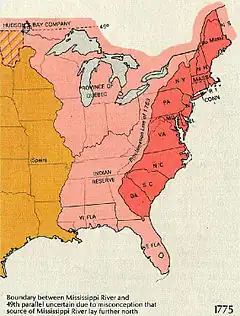
The European settlement of the Americas introduced a number of ingredients, spices, herbs, and cooking styles to the continent.
When European colonists came to Virginia, Pennsylvania, Massachusetts, and any of the other English colonies on the eastern seaboard of North America, their initial attempts at survival included planting crops familiar to them from back home in England. In the same way, they farmed animals for clothing and meat. Through hardships and the eventual establishment of trade with England, the West Indies and other regions, the colonists were able to derive a cuisine similar to what they had previously consumed in Britain and Ireland, while also introducing local animals and plants to their diet. American colonists followed along the line of British cookery up until the Revolution, when a desire to distinguish themselves from Britain led Americans to create "American" styles of cookery.[40]
In 1796, the first American cookbook was published, and others followed.[41] There was a general disdain for French cuisine/French cookery, even with French Huguenot settlers in South Carolina and French-Canadian emigrants in America. One of the cookbooks that proliferated in the colonies was The Art of Cookery Made Plain and Easy (1747) by Hannah Glasse, who referred to "the blind folly of this age that would rather be imposed on by a French booby, than give encouragement to a good English cook!" Of the French recipes given in the text, she speaks out flagrantly against the dishes as she "... think[s] it an odd jumble of trash."[42]
With the introduction of slavery, Africans were brought into the colonies. With them, came foods and ingredients such as bananas, peanuts, sweet potato, yams, and coffee, and cooking styles reminiscent of West African cuisines are still found in many dishes, especially in Southern cuisine.
The expulsion of the Acadians from Acadia led many of them to Louisiana, where they left a French influence in the diet of those settled in Louisiana, and among the Acadian Francophones who settled eastern Maine and parts of what is now northern Vermont at the same time they colonized New Brunswick.[43]
Some of the Jews who fled from the Inquisition with other Sephardic Jews in the 15th century had previously settled in Recife, Brazil and the West Indies, where their cuisine was influenced by new local ingredients like molasses, rum, sugar, vanilla, chocolate, peppers, corn, tomatoes, kidney beans, string beans and turkey. In 1654, twenty three Sephardic Jews arrived in New Amsterdam bringing this cuisine with them to the early colonial United States. Early American Jewish cuisine was heavily influenced by this branch of Sephardic cuisine. Many of the recipes were bound up in observance of traditional holidays and remained true to their origins. These included dishes such as stew and fish fried in olive oil, beef and bean stews, almond puddings, and egg custards. The first kosher cookbook in America was the Jewish Cookery Book by Esther Levy, published in 1871 in Philadelphia and includes many of the traditional recipes.[44]
Common ingredients
The American colonial diet varied depending on the settled region in which someone lived. Local cuisine patterns had been established by the mid-18th century. The New England colonies were extremely similar in their dietary habits to those that many of them had brought from England. As many of the New Englanders were originally from England, game hunting was useful when they immigrated to the New World. Many of the northern colonists depended upon their ability to hunt, or upon others from whom they could purchase game. Hunting was the preferred method of protein acquisition, as opposed to animal husbandry, which required much more work to defend the kept animals against raids[45]
A striking difference for the colonists in New England compared to other regions was seasonality.[46] While in the southern colonies, they could farm almost year-round, in the northern colonies, the growing seasons were very restricted. In addition, northern colonists' close proximity to the ocean gave them a bounty of fresh fish to add to their diet.
Wheat, the grain used to bake bread back in England, was almost impossible to grow, and imports of wheat were far from cost productive.[47] Substitutes in cases such as this included cornmeal. The Johnnycake was a poor substitute to some for wheaten bread, but acceptance by both the northern and southern colonies seems evident.[48]
Livestock and game
Commonly hunted game included deer, bear, buffalo, and wild turkey. The larger muscles of the animals were roasted and served with currant sauce, while the other smaller portions went into soups, stews, sausages, pies, and pastries.[49] In addition to the game, colonists' protein intake was supplemented by mutton.
The Spanish in Florida originally introduced sheep to the New World, but this development never quite reached the North, and there they were introduced by the Dutch and English. The keeping of sheep was a result of the English non-practice of animal husbandry.[50] The animals provided wool when young and mutton upon maturity after wool production was no longer desirable.[51] The forage-based diet for sheep that prevailed in the Colonies produced a characteristically strong, gamy flavor and a tougher consistency, which required aging and slow cooking to tenderize.[52]
Fats and oils

Fats and oils made from animals served to cook many colonial foods. Many homes had a sack made of deerskin filled with bear oil for cooking, while solidified bear fat resembled shortening.
Rendered pork fat made the most popular cooking medium, especially from the cooking of bacon. Pork fat was used more often in the southern colonies than the northern colonies as the Spanish introduced pigs earlier to the South. The colonists enjoyed butter in cooking as well, but it was rare prior to the American Revolution, as cattle were not yet plentiful.[53]
Alcoholic drinks
Prior to the Revolution, New Englanders consumed large quantities of rum and beer, as maritime trade provided them relatively easy access to the goods needed to produce these items. Rum was the distilled spirit of choice, as the main ingredient, molasses, was readily available from trade with the West Indies.
Further into the interior, however, one would often find colonists consuming whiskey, as they did not have similar access to sugar cane. They did have ready access to corn and rye, which they used to produce their whiskey.[54]
Until the Revolution, many considered whiskey to be a coarse alcohol unfit for human consumption, as many believed that it caused the poor to become raucous and unkempt drunkards.[55] In addition to these alcohol-based products produced in America, imports were seen on merchant shelves, including wine and brandy.[56]
Southern variations
In comparison to the northern colonies, the southern colonies were quite diverse in their agricultural diet. The uplands of Piedmont and the coastal lowlands made up the two main parts of the southern colonies.
The diet of the uplands often included wild game, cabbage, string beans, corn, squashes and white potatoes. People had biscuits as part of their breakfast, along with healthy portions of pork.[57] The lowlands of Louisiana included a varied diet heavily influenced by the French, Spanish, Acadians, Germans, Native Americans, Africans and Caribbeans. Rice played a large part of the diet in Louisiana. In addition, unlike the uplands, the lowlands subsistence of protein came mostly from coastal seafood. Much of the diet involved the use of peppers, as it still does to this day.[58][59]
Post-colonial cuisine
During the 18th and 19th centuries, Americans developed many new foods. Some, such as Rocky Mountain oysters, stayed regional; some spread throughout the nation but with little international appeal, such as peanut butter (a core ingredient of the peanut butter and jelly sandwich); and some spread throughout the world, such as popcorn, cola, fried chicken, cornbread, unleavened muffins such as the poppyseed muffin, and brownies.
19th-century American farmhouse
During the 1800s, American farms were mostly self-sufficient, but certain staples like salt, coffee, sugar, and baking soda would be purchased at the town general store. If the family did not grow wheat, then flour would also be purchased. Another luxury was canned salmon, which was sometimes eaten for Sunday dinner. Items purchased at the general store would be paid for with eggs, butter or some other food from the farm. Women were responsible for much of the processing of food like straining fresh milk, churning butter, making molasses from sorghum, grinding corn into cornmeal or cleaning whole chickens. Fresh picked apples were pressed into cider, which could be fermented to make apple cider vinegar. Fruits and vegetables were preserved by various means like canning, drying or pickling.
One contemporary writer from Michigan described October as cider season, when apple butter would be made. Her writings mention johnnycakes, and, as winter fare, buckwheat cakes.[60]
Typical farmhouse fare included fried chicken, simmered green beans, boiled corn, chicken and dumplings, fried ham, boiled beans and beets, stewed tomatoes, potatoes, and coleslaw made of shredded cabbage. Pon haus, similar to the scrapple of the Pennsylvania Dutch, was a typical breakfast dish among the Germans who had settled Indiana in the 19th century.
Pork scraps and corn meal were cooked into a thick porridge and molded in loaf pans. Once solidified, the mixture would be cut and fried. During the fall months, pork might be replaced with fried apples or potatoes. It was served with buttered biscuits, jam, jelly, milk gravy or sorghum syrup. Fruit butter might be made from apples, plums or peaches to accompany the meal.[60]
"A whole new class of city dwellers, harried, worried, furtive, hungry-looking people, have come into being in the wake of the kitchenette, and no modern influence has had so great a part in affecting the morals, health and spiritual well-being of a generation as has this ill-shapen, ill-planned adjunct of modern living"
Jane Pride, New York Herald
20th century
The 20th century revolutionized American cooking, with the advent of many new technologies, and a continued influx of immigrants with unique food traditions.
Pre-World War I
At the universities, nutritionists and home economists taught a new scientific approach to food. In the early 1900s muckraking journalists raised public concern about the wholesomeness of industrialized food products that contained various preservatives and adulterants of unknown safety. From 1902 to 1912 Harvey Washington Wiley, a chemist at the U.S. Department of Agriculture, supervised "hygienic table trials" to test the safety of food additives and preservatives. His work contributed to the enactment of the Pure Food and Drug Act of 1906. He became the first commissioner of the FDA and later led the laboratories of Good Housekeeping Magazine.[61]
During World War I the Progressives' moral advice about food conservation was emphasized in large-scale state and federal programs designed to educate housewives. Large-scale foreign aid during and after the war brought American standards to Europe.[62]
From 1912 to the end of the 1930s researchers discovered and popularized the role of various vitamins and minerals in human health. Starting with iodized salt in 1924, commercially distributed food began to be fortified with vitamins and minerals. In 1932, milk began to be fortified with viosterol, a purified vitamin D2 product. Synthetic thiamin (vitamin B1) first became available after 1936 and bakers began voluntarily enriching bread with high-vitamin yeast or synthetic vitamins in the late 1930s.
The cookware of the period was made of cast iron and these were thoroughly seasoned with pork fat. Fried salt pork with gravy was an indulgent fat-laden dish often served with a side of boiled potatoes. In the Appalachian region a dish called "killed lettuce" was made with pokeweed, dandelion and assorted wild greens that were drizzled with hot bacon grease until wilted or "killed".[60]
Pie could be served up to three times a day and many varieties were prepared depending on the season. During the spring months, pies would be made of rhubarb and strawberry; in summer peach, cherry, blackberry, blueberry, elderberry and grape; and in fall apple.[60]
The staples of the urban diet were bread, dairy and canned goods. Dinner might be tomato bisque from a can topped with cream or a salad made of canned string beans and mayonnaise. Many preferred to purchase food at delicatessens, rather than attempt to prepare meals in the cramped kitchenettes.
German delicatessens in cities like New York and Milwaukee sold imported cold cuts, potato salads, schmierkase, wienerwurst, North Sea herring, assorted pickles (pickled cucumber) and other prepared foods. Jewish immigrants from Germany soon followed suit, replacing pork dishes with corned beef (salt-cured beef) and pastrami. Ice cream soda was served at soda fountains, along with various other early "soda water" recipes like the Garden Sass Sundae (rhubarb) or the Oh-Oh-Cindy Sundae (strawberry ice cream topped with chocolate syrup, chopped nuts, whipped cream and candied cherries).[60]
During that same time frame, grain-feeding of cattle during low pasture months made milk increasingly available year-round. The invention of milking machines lowered production costs. Pasteurization, homogenization, evaporation, condensation, and refrigeration along with glass milk bottles, wax-paper cartons, and then plastic bottles made milk increasingly available and safe for urban consumers.[63] Milk became a staple food item and an increasingly important ingredient in American cuisine. Examples include the root beer float and the milkshake.
Pork was a staple of the rural diet through the Southern and Midwestern United States. Lard was used for baking, frying and even as a seasoning.

Major railroads featured upscale cuisine in their dining cars.[64] Restaurant chains emerged with standardized decor and menus, including the Fred Harvey restaurants along the route of the Santa Fe Railroad in the Southwest.[65]
World War II and later
The Food and Nutrition Board of the National Academy of Science established the first set of "Recommended Dietary Allowances" in 1941. In 1943, the US War Foods Administration issued the War Food Order No. 1, which made enriched bread the temporary law of the land.[66]
In 1945 George Stigler published an article on "The cost of subsistence" which described the so-called Stigler diet, his solution to the problem of providing a diet that met the RDA at a minimum cost.
The logistical requirements of the US military during WW2 and the Korean War spurred the development and growth of the processed foods industry in the US.[67] These wars encouraged the production of shelf-stable ingredients processed on a vast industrial scale. Examples include powdered milk, powdered eggs, potato flakes, and frozen concentrated orange juice.
After the war, low-cost, highly processed foods became one of the foundational elements of an era of mass prosperity.[68] Many companies in the American food industry developed new products requiring minimal preparation, such as frozen entrees.[69] One such example is the TV dinner in which a multi-course meal was assembled in aluminum packaging in a food factory and flash frozen, then reheated at home in a thermal oven to be served while watching TV.[70] Convenience foods of the era were designed to simplify home preparation.
One example is macaroni & cheese created using a powdered artificial cheese product that is reconstituted at home with fresh milk. Newspapers and magazines ran recipe columns, aided by research from corporate kitchens, which were major food manufacturers like General Mills, Campbell's, and Kraft Foods. For example, General Mills Betty Crocker's Cookbook, first published in 1950, was a popular book in American homes.[71][72]
Highly processed foods of the mid-20th century included novelty elements like multi-colored Jell-O using various chemical food colorings, prepared breakfast cereals marketed to children with large amounts of sugar and artificial colors (e.g. Froot Loops).[73] Fruit-flavored punches made with artificial fruit flavorings (e.g. Tang, Hi-C). Mid-20th-century foods also added novelty packaging elements like spray cheese in an aerosol can, pimento-stuffed olives, and drink pouches.
The development of the microwave oven resulted in the creation of industrial food products and packaging intended to take advantage of the opportunities and overcome the unique challenges of that technology.[74] Microwave popcorn is an example of such a product.
Throughout the second half of the 20th century the US commercial food system has become increasingly dependent on subsidized maize (corn) production to provide feed for livestock and ingredients for human foods such as high-fructose corn syrup.[75] It is estimated that the typical American gets 70 percent of their carbon intake from maize (corn) sources.[76]
The last half of the 20th century saw the development of controversial technological innovations intended to lower the cost of, improve the quality of, or increase the safety of commercial food including: food irradiation,[77] genetically modified organisms, livestock treated with antibiotics/hormones, and concentrated animal feeding operations. Activists have raised concerns about the wholesomeness, safety, or humaneness of these innovations and recommend alternatives such as organic produce, veganism/vegetarianism, and locavore diets.
Fast-food restaurants with standardized product and franchised service models began to appear and spread with the development of the highway system. White Castle (1916)[78] was one of the first examples. Franchising was introduced in 1921 by A&W Root Beer. The McDonald brothers created their "Speedee Service System" in 1948. Other examples include Burger King, KFC, Wendy's, Pizza Hut, Little Caesars, Domino's Pizza and Papa John's Pizza.
Ethnic influences
.jpg.webp)
One signature characteristic of American cooking is the fusion of multiple ethnic or regional approaches into completely new cooking styles. For example, spaghetti is Italian, while hot dogs are German; a popular meal, especially among young children, is spaghetti containing slices of hot dogs.[79][80] Since the 1960s, Asian cooking has played a particularly large role in American fusion cuisine.[81]

Some dishes that are typically considered American have their origins in other countries. American cooks and chefs have substantially altered these dishes over the years, to the degree that the dishes now enjoyed around the world are considered to be American. Hot dogs and hamburgers are both based on traditional German dishes, but in their modern popular form they can be reasonably considered American dishes.[82]
Pizza is based on the traditional Italian dish, brought by Italian immigrants to the United States, but varies highly in style based on the region of development since its arrival. For example, Chicago style has focus on a thicker, taller crust, whereas a "New York Slice" is known to have a much thinner crust which can be folded. These different types of pizza can be advertised throughout the country and are generally recognizable and well-known, with some restaurants going so far as to import New York tap water from a thousand or more miles away to recreate the signature style in other regions.[83]
Some dishes that Americans think of as being of "foreign" in origin and/or associated with a particular immigrant group were in fact invented in America and customized to American tastes. For example General Tso's chicken was invented by Chinese or Taiwanese chefs working in New York in the early 1970s.[84] The dish is unknown in China, except for a distant resemblance to a much spicier dish from Hong Kong said to have influenced the American version. The fortune cookie was likewise invented in California in the early 1900s and is known in Asia only as an American style food.[85]
.jpg.webp)
A wave of celebrity chefs began with Julia Child and Graham Kerr in the 1970s, with many more following after the rise of cable channels like Food Network. Probably the best-known television chef was Child, who taught French cuisine in her weekly show, The French Chef.[86] By the beginning of the 21st century, regional variations in consumption of meat began to reduce, as more meat was consumed overall.[87] Saying they eat too much protein, the 2015–2020 Dietary Guidelines for Americans asked men and teenage boys to increase their consumption of underconsumed foods such as vegetables.[88]
New American
During the 1980s, upscale restaurants introduced a mixing of cuisines that contain Americanized styles of cooking with foreign elements commonly referred to as New American cuisine,[89] a type of fusion cuisine combining flavors from the melting pot of traditional American cooking techniques with those from other cultures, sometimes adding molecular gastronomy components.[90][91]
21st century
In the 21st century, vegan and vegetarian meals increased in popularity, with more restaurants catering to vegans and vegetarians.[92][93][94]
Regional cuisines
In the present day, the modern cuisine of the United States is very regional in nature. Excluding Alaska and Hawaii, the terrain spans 3,000 miles (4,800 km) from east to west and more than 1,000 miles (1,600 km) from north to south.
New England
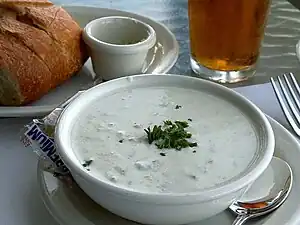
New England cuisine traces its roots to English cuisine and the Native American cuisine of the Abenaki, Narragansett, Niantic, Wabanaki, Wampanoag, and other native peoples. It also includes influences from French, Italian, and Portuguese cuisine, among others. It is characterized by the extensive use of potatoes, beans, dairy products and seafood. Corn, historically the main crop grown by Native American tribes in New England, continues to be grown in all New England states.[95][96] It is traditionally used in hasty pudding, cornbread and corn chowder. Three prominent foodstuffs native to New England are maple syrup, cranberries and blueberries. Maine is the only state with a commercial wild blueberry industry, with 105 million pounds harvested in 2021.[97]
Initial European colonists came from East Anglia in England. East Anglian cookery included dishes like suet puddings, soda breads, and a few shellfish delicacies, and would have been quite simple in contrast to the dishes prepared in contemporary London. Most of this cuisine was one-pot cookery, which developed into such dishes as succotash, chowder, baked beans, and others.[98]
The most popular starches in New England cuisine include potatoes and cornmeal, and a few native breads like Anadama bread, johnnycakes, bulkie rolls, Parker House rolls, popovers, ployes, and New England brown bread. Because of the influence of New Englander health reformers, the most well known of whom is Sylvester Graham, this region is fairly conservative with its spices, but typical spices include nutmeg, ginger, cinnamon, cloves, and allspice, especially in desserts, and for savory foods, thyme, black pepper, sea salt, and sage. Typical condiments include maple syrup, grown from the native sugar maple, molasses, and cranberry sauce.
The fruits of the region include the Vitis labrusca grapes used in grape juice made by companies such as Welch's, along with jelly, Kosher wine by companies like Mogen David and Manischewitz along with other wineries that make higher quality wines. Though not anywhere near as productive a region as the top three apple-producing regions, apples have been a staple of New England foodways since at least the 1640s, and it is here that a very high amount of heirloom varieties are found, many of them gaining renewed interest as part of locavore movements and the re-emergence of cider as a beverage of choice. Apples from New England would include varieties imported from their earliest in Europe and a few natives, like Baldwin, Lady, Mother, Pomme Grise, Porter, Roxbury Russet, Rhode Island Greening, Sops of Wine, Hightop Sweet, Peck's Pleasant, Titus Pippin, Westfield-Seek-No-Further, and Duchess of Oldenburg. Beach plums a small native species with fruits the size of a pinball, are sought after in summer to make into a jam. Cranberries are another fruit indigenous to the region, often collected in autumn in huge flooded bogs. Thereafter they are juiced so they can be drunk fresh for breakfast, or dried and incorporated into salads and quickbreads.[99]
Winter squashes like pumpkin and butternut squashes have been a staple for generations owing to their ability to keep for long periods over icy New England winters and being an excellent source of beta carotene; in summer, they are replaced with pattypan and zucchini, the latter brought to the region by immigrants from Southern Italy a century ago. Blueberries are a very common summertime treat owing to them being an important crop, and find their way into muffins, pies and pancakes.
Historically New England and the other original 13 colonies were major producers of hard cider and the only reason why this changed were that immigrants from Western and Central Europe preferred beer, especially lagers, to apple based alcohol. In more recent years cider has made a roaring comeback nationwide, with New England being the first to break out of the box and with many pomologists scouring the woods for abandoned apple trees and heirloom varieties to add to the cider press. Angry Orchard is a local commercial brand that began in New Hampshire but has since skyrocketed in sales, with other large marques following suit around the land.[100]
Typical favorite desserts are quite diverse, and encompass hasty pudding, blueberry pie, whoopie pies, Boston cream pie, pumpkin pie, Joe Frogger cookies, hand-crafted ice cream, Hermit cookies, and the chocolate chip cookie, invented in Massachusetts in the 1930s.
New England is noted for having a heavy emphasis on seafood, a legacy inherited from coastal tribes like the Wampanoag and Narragansett, who equally used the rich fishing banks offshore for sustenance. Favorite fish include cod, salmon, winter flounder, haddock, striped bass, pollock, hake, bluefish, and, in southern New England, tautog. All of these are prepared numerous ways, such as frying cod for fish fingers, grilling bluefish over hot coals for summertime, smoking salmon or serving a whole poached one chilled for feasts with a dill sauce, or, on cold winter nights, serving haddock baked in casserole dish with a creamy sauce and crumbled breadcrumbs as a top so it forms a crust.[101] Clam cakes, a savory fritter based on chopped clams, are a specialty of Rhode Island. Also, a hard shell clam is unique to Rhode Island called the Quahoag which is used in clear chowders. Farther inland, brook trout, largemouth bass, and herring are sought after, especially in the rivers and icy finger lakes in upper New England where New Englanders will fly fish for them in summertime.
Meat is present though not as prominent, and typically is either stewed in dishes like Yankee pot roast and New England boiled dinner or braised, as in a picnic ham; these dishes suit the weather better as summers are humid and hot but winters are raw and cold, getting below 0 °C for most of the winter and only just above it by March.[102] The roasting of whole turkeys began here as a centerpiece for large American banquets, and like all other East Coast tribes, the Native American tribes of New England prized wild turkeys as a source of sustenance and later Anglophone settlers were enamored of cooking them using methods they knew from Europe: often that meant trussing the bird and spinning it on a string or spit roasting. Today turkey meat is a key ingredient in soups, and also a favorite in several sandwiches like the Pilgrim. For lunch, hot roast beef is sometimes chopped finely into small pieces and put on a roll with salami and American or provolone cheese to make a steak bomb.[103] Bacon is often maple cured, and often bacon or salt pork drippings are an ingredient in corn chowder, a cousin of clam chowder.[104] Veal consumption was prevalent in the North Atlantic States prior to World War II.[87]
A variety of linguiça is favored as a breakfast food, introduced by Portuguese fishermen and Brazilian immigrants.[105] Dairy farming and its resultant products figure strongly on the ingredient list, and homemade ice cream is a summertime staple of the region: it was a small seasonal roadside stand in Vermont that eventually became the internationally famous Ben and Jerry's ice cream. Vermont is known for producing farmhouse style cheeses, especially a type of cheddar.[106] The recipe goes all the way back to colonial times when English settlers brought the recipe with them from England and found the rocky landscape eminently suitable to making the cheese.[107] Today Vermont has more artisanal cheese makers per capita than any other state, and diversity is such that interest in goat's milk cheeses has become prominent.[108]
Crustaceans and mollusks are also an essential ingredient in the regional cookery. Maine and Massachusetts, in more recent years, have taken to harvesting peekytoe crab and Jonah crab and making crab bisques, based on cream with 35% milkfat, and crabcakes out of them: often these were overlooked as bycatch of lobster pots by fishermen of the region, but in the past 30 years their popularity has firmly established them as a staple. They even appear on the menu as far south as to be out of the region in New York, where they are sold to four star restaurants in the form of cocktail claws. Whelks are eaten in salad, and lobster, which is indigenous to the coastal waters of the region and are a feature of many dishes, baked, boiled, roasted, and steamed, or simply eaten as a sandwich, chilled with mayonnaise and chopped celery in Maine and Massachusetts, or slathered with melted butter on Long Island and in Connecticut. Shellfish of all sorts are part of the diet, and shellfish of the coastal regions include little neck clams, sea scallops, blue mussels, oysters, soft shell clams, and razor shell clams. Much of this shellfish contributes to New England tradition, the clambake. The clambake as known today is a colonial interpretation of an American Indian tradition.[109]
In summer, oysters and clams are dipped in batter and fried, often served in a basket with french fries, or commonly on a wheaten bun as a clam roll. Oysters are otherwise eaten chilled on a bed of crushed ice on the half shell with mignonette sauce, and are often branded on where they were harvested. Large quahogs are stuffed with breadcrumbs and seasoning and baked in their shells, and smaller ones often find their way into clam chowder. Other preparations include clams casino, clams on the half shell served stuffed with herbs like oregano and streaky bacon.
Southern New England, particularly along the coast, shares many specialties with the Mid-Atlantic, including especially dishes from Jewish and Italian-American cuisine. Coastal Connecticut is known for distinctive kinds of pizza, locally called apizza (pronounced locally as abeetz), differing in texture (thin and slightly blackened) and toppings (such as clams) from pizza further south in the so-called pizza belt, which stretches from New Haven, Connecticut southward through New York, New Jersey, and into Maryland.
Delaware Valley and Mid-Atlantic
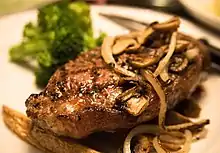
The mid-Atlantic states comprise the states of New York, New Jersey, Delaware, Pennsylvania, and Northern Maryland. The oldest major settlement in this area of the country is found in the most populous city in the nation, New York, founded in 1625 by the Dutch. Today, it is a major cultural capital of the United States.[110]
The influences on cuisine in this region are extremely eclectic owing to the fact that it has been and continues to be a gateway for international culture as well as a gateway for new immigrants.[111] Going back to colonial times, each new group has left their mark on homegrown cuisine and in turn the cities in this region disperse trends to the wider United States. In addition, cities like New York and Philadelphia have had the past influence of Dutch,[112] Italian, German,[113] Irish,[114][115] British,[116] and Jewish cuisines,[117] and that continues to this day. Baltimore has become the crossroads between North and South, a distinction it has held since the end of the Civil War.
A global power city,[118] New York is well known for its diverse and cosmopolitan dining scene.[119] Its restaurants compete fiercely for good reviews in the Food and Dining section of The New York Times, online guides, and Zagat's, the last of which is widely considered the premier American dining guide, published yearly and headquartered in New York.

Many of the more complicated dishes with rich ingredients like Lobster Newberg, waldorf salad, vichyssoise, eggs benedict, and the New York strip steak were born out of a need to entertain and impress the well-to-do in expensive bygone restaurants like Delmonico's and still standing establishments like the Waldorf-Astoria Hotel.[120][121] Modern commercial American cream cheese was developed in 1872.[122]
Since the first reference to an alcoholic mixed drink called a cocktail comes from New York State in 1803, it is not a surprise that there have been many cocktails invented in New York and the surrounding environs. Even today New York bars are noted for being highly influential in making national trends. Cosmopolitans, Long Island iced teas, Manhattans, Rob Roys, Tom Collins, Aviations, and Greyhounds were all invented in New York bars, and the gin martini was popularized in New York in speakeasies during the 1920s, as evidenced by its appearance in the works of New Yorker and American writer F. Scott Fitzgerald. Like its neighbor Philadelphia, many rare and unusual liquors and liqueurs often find their way into a mixologist's cupboard or restaurant wine list.
New York State is the third most productive area in the country for wine grapes, just behind California and Washington. It has AVA's near the Finger Lakes, the Catskills, and Long Island,[123] and in the Hudson Valley has the second-most productive area in the country for growing apples, making it a center for hard cider production, just like New England.[124][125] Pennsylvania has been growing rye since Germans began to emigrate to the area at the end of the 17th century and required a grain they knew from Germany.[126] Therefore, overall it is not unusual to find New York grown Gewürtztraminer and Riesling, Pennsylvania rye whiskey, or marques of locally produced ciders like Original Sin on the same menu.
Since their formative years, New York, Philadelphia, and Baltimore have welcomed immigrants of every kind to their shores, and all three have been an important gateway through which new citizens to the general United States arrive.[127] Traditionally natives have eaten cheek to jowl with newcomers for centuries as the newcomers would open new restaurants and small businesses and all the different groups would interact.
Even in colonial days this region was a very diverse mosaic of peoples, as settlers from Switzerland, Wales, England, Ulster, Wallonia, Holland, Gelderland, the British Channel Islands, and Sweden sought their fortune in this region.[128][129] This is very evident in many signature dishes and local foods, all of which have evolved to become American dishes in their own right.
The original Dutch settlers of New York brought recipes they knew and understood from the Netherlands and their mark on local cuisine is still apparent today: in many quarters of New York their version of apple pie with a streusel top is still baked. In the colony of New Amsterdam, their predilection for waffles in time evolved into the American national recipe and forms part of a New York brunch. They also made coleslaw, originally a Dutch salad, but today accented with the later 18th-century introduction of mayonnaise.[112][130][131]
The doughnut began its life originally as a New York pastry that arrived in the 18th century as the Dutch olykoek, with later additions from other nations of Europe like the Italian zeppole, the Jewish/Polish pączki, and the German Berliner arriving in the 19th century to complete the variety found in modern doughnuts today.[132]

Crab cakes were once a kind of English croquette, but over time as spices have been added they and the Maryland crab feast became two of Baltimore's signature dishes. Fishing for blue crab is a favorite summer pastime in the waters off Maryland, New Jersey, and Delaware where they may grace the table at summer picnics.
Other mainstays of the region have been present since the early years of American history, like oysters from Cape May, the Chesapeake Bay, and Long Island, and lobster and tuna from the coastal waters found in New York and New Jersey.[133][134] Philadelphia Pepper Pot, a tripe stew, was originally a British dish but today is a classic of home cooking in Pennsylvania alongside bookbinder soup, a type of turtle soup.
In the winter, New York pushcarts sell roasted chestnuts, a delicacy dating back to English Christmas traditions,[135] and it was in New York and Pennsylvania that the earliest Christmas cookies were introduced: Germans introduced crunchy molasses-based gingerbread and sugar cookies in Pennsylvania, and the Dutch introduced cinnamon-based cookies, all of which have become part of the traditional Christmas meal.[136][137]
Scrapple was originally a type of savory pudding that early Pennsylvania Germans made to preserve the offal of a pig slaughter.[138] The Philadelphia soft pretzel was originally brought to Eastern Pennsylvania in the early 18th century, and later, 19th-century immigrants sold them to the masses from pushcarts to make them the city's best-known bread product, having evolved into its own unique recipe.[139]

After the 1820s, new groups began to arrive and the character of the region began to change. There had been some Irish from Ulster prior to 1820, however largely they had been Protestants with somewhat different culture and (often) a different language than the explosion of emigrants that came to Castle Garden and Locust Point in Baltimore in their masses starting in the 1840s.
The Irish arrived in America in a rather woeful state, as Ireland at the time was often plagued by some of the worst poverty in Europe and often heavy disenfranchisement among the masses. Many of them arrived barely alive having ridden coffin ships to the New World, very sick with typhus and gaunt from prolonged starvation.
In addition, they were the first to face challenges other groups did not have: they were the first large wave of Catholics. They faced prejudice for their faith and the cities of Philadelphia, New York, and Baltimore were not always set up for their needs.
For example, Catholic bishops in the U.S. mandated until the 1960s that all Catholics were forbidden from eating red meat on Fridays and during Lent,[140] and attending Mass sometimes conflicted with work as produce and meat markets would be open on high holy days; this was difficult for Irishmen supporting families since many worked as laborers.
Unsurprisingly, many Irishmen also found their fortunes working as longshoremen, which would have given their families access to fish and shellfish whenever a fisherman made berth, which was frequent on the busy docks of Baltimore and New York.[141][142]
Though there had been some activity in Baltimore in founding a see earlier by the Carrolls, the Irish were the first major wave of Catholic worship in this region, and that meant bishops and cardinals sending away to Europe for wine. Wine, with water, is consecrated as part of the Catholic Mass.
Taverns had existed prior to their emigration to America in the region, though the Irish brought their particular brand of pub culture and founded some of the first saloons and bars that served Dublin style stout and red ale; they brought with them the knowledge of single-malt style whiskey and sold it.
The Irish were the first immigrant group to arrive in this region in massive millions, and these immigrants also founded some of the earliest saloons and bars in this region, of which McSorley's is a still operating example.

It was also in this region that the Irish introduced something that today is a very important festival in American culture that involves a large amount of food, drink, and merry making: Halloween. In England and Wales, where prior immigrants had come from, the feast of All Hallows Eve had died out in the Reformation, dismissed as superstition and excess having nothing to do with the Bible and often replaced with the festival of Guy Fawkes Night. Other immigrant groups like the Germans preferred to celebrate October 31 as Reformation Day, and after the American Revolution all of the above were less and less eager to celebrate the legacy of an English festival given they had fought against Great Britain for their independence.
The Catholicism of the Irish demanded attendance at church on November 1 and charity and deeds, not just faith, as a cornerstone of dogma, and many of their older traditions survived the Reformation and traveled with them. Naturally, they went door-to-door to collect victuals for masked parties as well as gave them out, like nuts to roast on the fire, whiskey, beer, or cider, and barmbracks; they also bobbed for apples and made dumb cakes. Later in the century they were joined by Scots going guising, children going door-to-door to ask for sweets and treats in costume.
From the Mid-Atlantic this trend spread to be nationwide and evolved into American children trick-or-treating on October 31 wearing costumes and their older counterparts having wild costume parties with various foods and drinks such as caramel apples, candy apples, dirt cakes, punch, cocktails, cider (both alcoholic and non,) pumpkin pie, candy corn, chocolate turtles, peanut brittle, taffy, tipsy cake, and copious buckets full of candy; children carving jack-o-lanterns and eating squash derived foods derive from Halloween's heritage as a harvest festival and from Irish and Scottish traditions of carving turnips and eating root vegetables at this time of year.
Bobbing for apples has survived to the present day as a Halloween party classic game, as has a variation on the parlor game of trying to grab an apple hanging from the ceiling blindfolded:[143] it has evolved into trying to catch a donut in one's teeth.[144]
Immigrants from Southern Europe, namely Sicily, Campania, Lazio, and Calabria, appeared between 1880 and 1960 in New York, New Jersey, Pennsylvania, and Eastern Maryland hoping to escape the extreme poverty and corruption endemic to Italy.
Typically none of them spoke English, but rather dialects of Italian and had a culture that was more closely tied to the village they were born in than the high culture only accessible to those who could afford it at this time; many could not read or write in any language.
They were employed in manual labor or factory work but it is because of them that dishes like spaghetti with meatballs, New York–style pizza, calzones, and baked ziti exist, and Americans of today are very familiar with semolina based pasta noodles.
Their native cuisine had less of an emphasis on meat, as evidenced by dishes they introduced like pasta e fagioli and minestrone, but the dishes they created in America often piled it on as a sign of wealth and newfound prosperity since for the first time even cheap cuts of it were affordable. The American recipe for lasagna is proof of this, as mostly it is derived from the Neapolitan version of the dish with large amounts of meat and cheese.[145]

New York–style hot dogs came about with German-speaking emigrants from Austria and Germany, particularly with the frankfurter sausage and the smaller wiener sausage; Jews would also contribute here by introducing the kosher version of these sausages, made of beef rather than pork.[146] Today, the New York–style hot dog with sauerkraut, mustard, and the optional cucumber pickle relish is such a part of the local fabric, that it is one of the favorite comestibles of New York and both the pork and the beef versions are beloved. Hot dogs are a typical street food sold year round in all but the most inclement weather from thousands of pushcarts.
As with all other stadiums in Major League Baseball they are an essential for New York Yankees and the New York Mets games though it is the local style of preparation that predominates without exception.
Hot dogs are also the focus of a televised eating contest on the Fourth of July in Coney Island,[147] at Nathan's Famous, one of the earliest hot dog stands opened in the United States in 1916 by Nathan Handwerker. Handwerker was a Jewish man who emigrated from what is now Ukraine in 1912 and whose influence is felt today around the world.
Coney Island is most famous for being a traditional boardwalk amusement park and the site of the world's first rollercoaster, a precursor of modern theme parks. Hot dogs are a staple of amusement parks 100 years later.[148]
A summertime treat, Italian ice, began its life as a sweeter adaptation of the Sicilian granita that was strictly lemon-flavored and brought to New York and Philadelphia. Its Hispanic counterpart, piragua, is a common shaved-ice treat brought to New York by Puerto Ricans in the 1930s. Unlike the original dish which included flavors like tamarind, mango, coconut, piragua is evolving to include flavors like grape and cherry, fruits which are impossible to grow in the tropical Puerto Rican climate and get exported back to the island from New York.[149]
Taylor Ham, a meat delicacy of New Jersey, first appeared around the time of the Civil War and today is often served for breakfast with eggs and cheese on a kaiser roll, a variant of a roll brought to the area by Austrians in the second half of the 19th century, now commonly used for sandwiches at lunchtime, often topped with poppyseeds. This breakfast meat is generally known as pork roll in southern New Jersey and Philadelphia, and Taylor Ham in northern New Jersey.

Other dishes came about during the early 20th century and have much to do with delicatessen fare, set up largely by Jewish immigrants from Eastern Europe who came to America incredibly poor, often illiterate in any other language but Yiddish, and often banished from mainstream society in their place of origin for centuries. Most often they were completely unable to partake in the outdoor food markets that the general population utilized as most of the food for sale was not kosher.
The influence of European Jewry before their destruction in the Holocaust on modern mid-Atlantic cooking remains strong and reinforced by their many descendants in the region.[150] These currently form the largest concentration of Jews outside Tel Aviv and are very integrated into the local mainstream of New York in particular.
American-style pickles, now a common addition to hamburgers and sandwiches, were brought by Polish Jews,[151] and Austro-Hungarian Jews brought a recipe for almond horns that now is a common regional cookie, diverting from the original recipe in dipping the ends in dark chocolate.[152][153]
New York–style cheesecake has copious amounts of cream and eggs because animal rennet is not kosher and so could not be sold to a large number of the deli's clientele.
New York inherited its bagels and bialys from Jews, as well as Challah bread. Pastrami first entered the country via Romanian Jews, and is a feature of many sandwiches, often eaten on marble rye, a bread that was born in the mid-Atlantic.
Whitefish salad, lox, and matzoh ball soup are now standard fare made to order at local diners and delicatessens, but started their life as foods that made up a strict dietary code. Rugelach cookies and hamentashen are sweet staples still sold to the general public, but came to New York over a century ago with Ashkenazi Jews along with Jewish rye.[154][155]
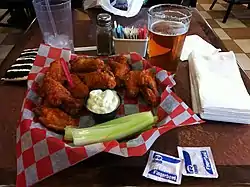
Many of their dishes passed into the mainstream enough that they became standard fare in diners by the end of the 20th century, a type of restaurant that is now the most common in the region, and the subject matter of the artist Edward Hopper.
In the past this sort of establishment was the haven of the short-order cook grilling or frying simple foods for the working man. Today typical service includes staples from this large region like beef on weck, Manhattan clam chowder, the club sandwich, Buffalo wings, Philadelphia cheesesteak, the black and white cookie, shoofly pie, snapper soup, Smith Island cake, blackout cake, grape pie, milkshakes, and the egg cream, a vanilla or chocolate fountain drink with a frothy top and fizzy taste.
As in Hopper's painting from 1942, many of these businesses are open 24 hours a day.
Midwest
This region today comprises the states near the Great Lakes and also the Great Plains; much of it is prairie with very flat terrain. Winters are bitterly cold, windy, and wet. Midwestern cuisine today is a very eclectic and odd mix and match of foodways, covering everything from Kansas City–style barbecue to the Chicago-style hot dog, though many of its classics are very simple, hearty fare.
This region was mostly untouched by European and American settlers until after the American Revolutionary War, and excepting Missouri and the heavily forested states near the Great Lakes, was mainly populated by nomadic tribes like the Sioux, Osage, Arapaho, and Cheyenne. As with most other American Indians tribes, these tribes consumed the Three Sisters of beans, maize, and squash, but also for thousands of years followed the herds of bison, hunting them on foot and later on horseback, typically using bow and arrow. There are buffalo jumps dating back nearly 10,000 years and several photographs and written accounts of trappers and homesteaders attesting to their dependence on the buffalo and to a lesser degree elk.
After nearly wiping out elk and bison, this region has taken to raising bison alongside cattle for their meat and at an enormous profit, making them into burgers and steaks.
Often that means harsh blizzards especially near the Great Lakes where Arctic winds blow off of Canada, where ice on rivers and lakes freezes thick enough for ice hockey, and for ice fishing for pike, walleye and panfish to be ubiquitous. In Minnesota, Wisconsin, and Michigan, they often become part of the local fish fry.
.jpg.webp)
The primary meats here are beef and poultry, since the Midwest has been raising turkeys, chickens, and geese for over 150 years. Chickens have been common for so long that the Midwest has several native breeds that are prized for both backyard farming and for farmer's markets, such as the Buckeye and Wyandotte. One, Billina, appears as a character in the second book of the Oz series by L. Frank Baum.
Favorite fruits of the region include some native plants inherited from Native American tribes like the pawpaw, and American persimmons are also highly favored.
As in the American South, pawpaws are the region's largest native fruit, about the size of a mango, often found growing wild come September; they are made into preserves and cakes and command quite a price at farmer's markets in Chicago.[156]
The American persimmon is often smaller than its Japanese cousin, about the size of a small plum, but in the Midwest and parts of the East it is the main ingredient in the steamed persimmon pudding, topped with crème anglaise.
Other crops inherited from the Native Americans include wild rice, which grows on the banks of lakes and is a local favorite for fancy meals and today often used in stuffing for Thanksgiving.
Typical fruits of the region are cold-weather crops. Once it was thought that its winters were too harsh for apples, but a breeder in Minnesota produced the Wealthy apple and it became the third-most productive region for apple growing in the country, with local varieties comprising Wolf River, Enterprise, Melrose, Paula Red, Rome Beauty, Honeycrisp, and the Red Delicious.
Cherries are important to Michigan and Wisconsin grows many cranberries, a legacy of early-19th-century emigration of New England farmers. Crabapple jelly is a favorite condiment of the region.
The influence of German, Scandinavian, and Slavic peoples on the northern portion of the region is very strong; many emigrated to Wisconsin, Minnesota, Michigan, Ohio, and Illinois in the 19th century to take advantage of jobs in the meatpacking business as well as being homesteaders and tradesmen.
Bratwurst is a very common sausage eaten at tailgate parties for the Green Bay Packers, Chicago Bears, or Detroit Lions, often served boiled in lager beer with sauerkraut, different from many of the recipes currently found in Germany.
Polish sausage, in particular a locally invented type of kielbasa, is essential for sporting events in Chicago: Chicago today has approximately 200,000 Polish speakers and has had a similar population for over 100 years.[157]
When Poles came to Chicago and surrounding cities from Europe, they brought with them long ropes of kielbasa, cabbage rolls, and pierogi. Poles that left Poland after the fall of the Berlin Wall and descendants of earlier immigrants still make them, and they remain common in local diners and delis.[158]
Today alongside the pierogi, the sausage is served on a long roll with mustard like a hot dog or as a Maxwell Street Polish, a sandwich with caramelized onions. In Cleveland, the same sausage is served in the form of the Polish boy, a sandwich made of french fries, spicy barbecue sauce, and coleslaw.
Unlike cities in the East where the hot dog alone is traditional, fans of the Cleveland Indians, Detroit Tigers, Chicago Cubs, and Milwaukee Brewers favor two or three different kinds of sausage sold in the pushcarts outside the stadium.
The hot dogs themselves tend to follow the Chicago style, with mustard and pickled vegetables.
In Cincinnati, where the Cincinnati Reds play, there is a competitor in Cincinnati chili. Invented by Macedonian immigrants, it includes spaghetti as its base, chili with a Mediterranean-inspired spice mix, and cheddar cheese; the chili itself is often a topping for local hot dogs at games.
In the Midwest and especially Minnesota,[159] the tradition of the church potluck is a gathering where local foods reign, and has been since the era of the frontier; pioneers often needed to pool resources to have a celebration in the 19th century and that simply never changed.[160]
Nowhere is this more clear than with the hotdish, a type of casserole believed to have derived from a Norwegian recipe, it is usually topped with potatoes or tater tots.[161] Next to the hotdish at potlucks usually glorified rice is found, a kind of rice pudding mixed with crushed pineapple and maraschino cherries. Next to that is the booyah, a thick soup made of meat, vegetables, and seasonings that is meant to simmer on the stove for up to two days.
Lefse, traditionally a Scandinavian flatbread, has been handed down to descendants for over a hundred years and is common on the table. Behind that is venison, a popular meat around the Great Lakes and often eaten as steaks, sandwiches, and crown roasts for special events.[162][163] Within Wisconsin, Minnesota and the Dakotas, tiger meat, a dish similar to steak tartare, is common.
Last on the table are the dessert bars and brownies, created originally in 1898 in Chicago, now a global food and international favorite.[164]
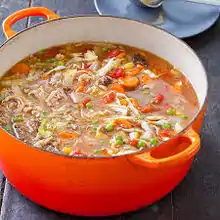
Further south, barbecue has its own style in places in Kansas City and St. Louis different from the South and American West. Kansas City and St. Louis were and are important hubs for the railroad that connected the plains with the Great Lakes and cities farther east, like Philadelphia.[165]
At the turn of the 19th century, the St. Louis area, Omaha, and Kansas City had huge stockyards, waystations for cattle and pigs on their way east to the cities of the coast and north to the Great Lakes.[166][167] They all had large growing immigrant and migrant populations from Europe and the South respectively, so the region has developed unique styles of barbecue.
St. Louis–style barbecue favors a heavy emphasis on a sticky sweet barbecue sauce. Its standbys include the pork steak, a cut taken from the shoulder of the pig, grilled then slowly stewed in a pan over charcoal; crispy snoots, a cut from the cheek and nose of the pig that is fried up like cracklins and eaten dipped in sauce; pork spare ribs; and a mix of either beer-boiled bratwurst or grilled Italian sausage, flavored with fennel.
Dessert is usually something like gooey butter cake, invented in the city in the 1930s.
Kansas City–style barbecue uses several different kinds of meat, more than most styles of American barbecue—turkey, mutton, pork, and beef to name a few—but is distinct from St. Louis in that the barbecue sauce adds molasses in with the tomato-based recipe and typically has a more tart taste.
Traditionally, Kansas City uses a low-and-slow method of smoking the meat in addition to just stewing it in the sauce. It also favors using hickory wood for smoking and continual watering or layering of the sauce while cooking to form a glaze; with burnt ends this step is necessary to create the "bark" or charred outer layer of the brisket.
Southern United States
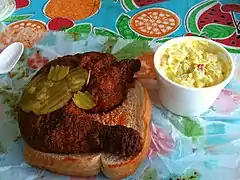
When referring to the American South as a region, typically it should indicate Southern Maryland and the states that were once part of the Old Confederacy, with the dividing line between the East and West jackknifing about 100 miles west of Dallas, Texas, and mostly south of the old Mason–Dixon line. Cities found in this area include New Orleans, Atlanta, Washington, D.C., Memphis, Charleston, and Charlotte with Houston, Texas being the largest. The Florida Panhandle is usually considered part of the South, but the Florida peninsula (especially its lower half) is not.
These states are much more closely tied to each other and have been part of U.S. territory for much longer than states much farther west than East Texas, and in the case of food, the influences and cooking styles are strictly separated as the terrain begins to change to prairie and desert from bayou and hardwood forest.

This section of the country has some of the oldest known U.S. foodways, with some recipes almost 400 years old.
Native American influences are still quite visible in the use of cornmeal as an essential staple[168] and found in the Southern predilection for hunting wild game, in particular wild turkey, deer, woodcock, and various kinds of waterfowl; for example, coastal North Carolina is a place where hunters will seek tundra swan as a part of Christmas dinner; the original English and Scottish settlers would have rejoiced at this revelation owing to the fact that such was banned among the commoner class in what is now the United Kingdom, and naturally, their descendants have not forgotten.[169][170]
Native Americans also consumed turtles and catfish, specifically the snapping turtle, the alligator snapping turtle, and blue catfish. Catfish are often caught with one's bare hands, gutted, breaded, and fried to make a Southern variation on English fish and chips and turtles are turned into stews and soups.[171][172]
Native American tribes of the region such as the Cherokee or Choctaw often cultivated or gathered local plants like pawpaw, maypop and several sorts of squashes and corn as food.[173] They also used spicebush[174] and sassafras as spices,[175] and the aforementioned fruits are still cultivated as food in the South.[176]
Maize is to this day found in dishes for breakfast, lunch and dinner in the form of grits, hoecakes, baked cornbread, and spoonbread, and nuts like the hickory, black walnut and pecan are commonly included in desserts and pastries as varied as mince pies, pecan pie, pecan rolls and honey buns (both are types of sticky bun), and quick breads, which were themselves invented in the South during the American Civil War.
Peaches have been grown in this region since the 17th century and are a staple crop as well as a favorite fruit, with peach cobbler being a signature dessert.
Early history
European influence began soon after the settlement of Jamestown in 1607 and the earliest recipes emerged by the end of the 17th century. Specific influences from Europe were quite varied, and they remain traditional and essential to the modern cookery overall.
German speakers often settled in the Piedmont on small farms from the coast, and invented an American delicacy that is now nationally beloved, apple butter, based on their recipe for apfelkraut, and later they introduced red cabbage and rye.
From the British Isles, an enormous amount of influence was bestowed upon the South, specifically foodways from 17th- and 18th-century Ulster, the borderlands between England and Scotland, the Scottish Highlands, portions of Wales, the West Midlands, the West Country, Black Country and Southern England. Settlers bound for America fled the tumult of the Civil War, Ulster and the Highland Clearances.
Often ships' manifests show their belongings nearly always included cookpots or bakestones and seed stock for plants like peaches, plums, and apples to grow orchards which they planted in their hundreds. Each group brought foods and ideas from their respective regions.
Settlers from Ireland and Scotland were well known for creating peatreak and poitín, strong hard liquor based on fermenting potatoes or barley. In time they came up with a method for distilling a corn mash with added sugar and aging in charred barrels made of select hardwoods, which created a whiskey with a high proof. This gave birth to American whiskey and Kentucky bourbon, and its cousins moonshine and Everclear.
Closer to the coast, 18th-century recipes for English trifle turned into tipsy cakes, replacing the sherry with whiskey and their recipe for pound cake, brought to the South around the same time, still works with American baking units: one pound sugar, one pound eggs, one pound butter, one pound flour.
Common features

Pork is the popular choice in 80% of Southern style barbecue and features in other preparations like sausages and sandwiches. For most Southerners in the antebellum period, corn and pork were staples of the diet.[87] Country sausage is an ingredient in the Southern breakfast dish of biscuits and gravy. Country ham is often served for breakfast and cured with salt or sugar and hickory-smoked.[177]
Accompanying many meals is the southern style fluffy biscuit, where the leavening agent is baking soda and often includes buttermilk, and for breakfast they often accompany country ham, grits, and scrambled eggs.
Desserts
Desserts in the South tend to be quite rich and very much a legacy of entertaining to impress guests, since a Southern housewife was (and to a degree still is) expected to show her hospitality by laying out as impressive a banquet as she is able to manage.[178]
Desserts are vast and encompass Lane cake, sweet potato pie, peach cobbler, pecan pie, hummingbird cake, Jefferson Davis pie, peanut brittle, coconut cake, apple fritters, peanut cookies, Moravian spice cookies, chess pie, doberge cake, Lady Baltimore cake, bourbon balls, and caramel cake.

American-style sponge cakes tend to be the rule rather than the exception as is American buttercream, a place where Southern baking intersects with the rest of the United States. Nuts like pecan and hickory tend to be revered as garnishes for these desserts, and they make their way into local bakeries as fillings for chocolates.
Cajun and Creole cuisine of Louisiana
In Louisiana, cooking methods have more in common with rustic French cuisines of the 17th and 18th century than anything ever found at the French court in Versailles or the bistros of 19th- and 20th-century Paris; this is especially true of Cajun cuisine.
Cajun French is more closely related to dialects spoken in Northern Maine, New Brunswick, and to a lesser degree Haiti than anything spoken in modern France, and likewise their terminology, methodology, and culture concerning food is much more closely related to the styles of these former French colonies even today.
Unlike other areas of the South, Cajuns were and still are largely Catholics and thus much of what they eat is seasonal; for example pork is an important component of the Cajun boucherie (a large community event where the hog is butchered, prepared with a fiery spice mix, and eaten snout to tail) but it is never consumed in the five weeks of Lent, when such would be forbidden.
Cajun cuisine tends to focus on what is locally available, historically because Cajuns were often poor, illiterate, independent farmers and not plantation owners but today it is because such is deeply imbedded in local culture.
Boudin is a type of sausage found only in this area of the country, and it is often by far more spicy than anything found in France or Belgium. Chaudin is unique to the area, and the method of cooking is comparable to the Scottish dish haggis: the stuffing includes onions, rice, bell peppers, spices, and pork sewn up in the stomach of a pig, and served in slices piping hot.
Crawfish are a staple of the Cajun grandmother's cookpot, as they are abundant in the bayous of Southern Louisiana and a main source of livelihood, as are blue crabs, shrimp, corn on the cob, and red potatoes, since these are the basic ingredients of the Louisiana crawfish boil.

New Orleans has been the capital of Creole culture since before Louisiana was a state. This culture is that of the colonial French and Spanish that evolved in the city of New Orleans, which was and still is quite distinct from the rural culture of Cajuns and dovetails with what would have been eaten in antebellum Louisiana plantation culture long ago.
Cooking to impress and show one's wealth was a staple of Creole culture, which often mixed French, Spanish, Italian, German, African, Caribbean and Native American cooking methods, producing rich dishes like oysters bienville, pompano en papillote, and even the muffaletta sandwich.
However, Louisiana Creole cuisine tends to diverge from the original ideas brought to the region in ingredients: profiteroles, for example, use a near identical choux pastry to that which is found in modern Paris but often use vanilla or chocolate ice cream rather than custard as the filling, pralines nearly always use pecan and not almonds, and bananas foster came about when New Orleans was a key port for the import of bananas from the Caribbean Sea.[179]
Gumbos tend to be thickened with okra, or the leaves of the sassafrass tree. Andouille is often used, but not the andouille currently known in France, since French andouille uses tripe whereas Louisiana andouille is made from a Boston butt, usually inflected with pepper flakes, and smoked for hours over pecan wood.
Other ingredients that are native to Louisiana and not found in the cuisine of modern France would include rice, which has been a staple of both Creole and Cajun cooking for generations, and sugarcane, which has been grown in Louisiana since the early 1800s.[180]

Ground cayenne pepper is a key spice of the region, as is the meat of the American alligator, something settlers learned from the Choctaws and Houma. The maypop plant has been a favorite of Southerners for 350 years; it gives its name to the Ocoee River in Tennessee, a legacy of the Cherokees, and in Southern Louisiana it is known as liane de grenade, indicating its consumption by Cajuns. It is a close relative of the commercial passionfruit, similar in size, and is a common plant growing in gardens all over the South as a source of fresh summertime fruit.
African American influences
West African influences came with enslaved peoples from Ghana, Benin, Mali, Congo, Angola, Sierra Leone, Nigeria, and other portions of the Gold Coast, and the mark Africans and their descendants, the African Americans, have made on Southern food is strong today and an essential addition to the Southern table.
Crops like okra, sorghum, sesame seeds, eggplant, and many different kinds of melons were brought with them from West Africa along with the incredibly important introduction of rice to the Carolinas and later to Texas and Louisiana, whence it became a staple grain of that region and still remains a staple in those areas today, found in dishes like Hoppin John, purloo, and Charleston red rice.
Like the poorer indentured servants that came to the South, slaves often got the leftovers of what was slaughtered for the consumption of the master of the plantation and so many recipes had to be adapted for offal, like pig's ears and fatback[181] though other methods encouraged low and slow methods of cooking to tenderize the tougher cuts of meat, like braising, smoking, and pit roasting, the last of which was a method known to West Africans in the preparation of roasting goat.[182]
Peanut soup is one of the oldest known recipes brought to Virginia by Africans and over time, through their descendants, it has become creamier and milder tasting than the original.[183]
Florida cuisine
Certain portions of the South often have their own distinct subtypes of cuisine owing to local history and landscape. Floridian cuisine, for example, has a distinct way of cooking that includes different ingredients, especially south of Tampa and Orlando.
Spain had control of the state until the early 19th century and used the southern tip as an outpost to guard the Spanish Main beginning in the 1500s, but Florida kept and still maintains ties with the Caribbean Sea, including the Bahamas, Haiti, Cuba, Puerto Rico, the Dominican Republic, and Jamaica.
South of Tampa, there are and have been for a long time many speakers of Caribbean Spanish, Haitian French, Jamaican Patois, and Haitian Creole and each Caribbean culture has a strong hold on cooking methods and spices in Florida. In turn, each mixes and matches with the foodways of the Seminole tribe and Anglophone settlers. Thus, for almost 200 years, Floridian cooking has had a more tropical flavor than any other Southern state.
Allspice, a spice originally from Jamaica, is an ingredient found in spice mixes in summer barbecues along with ginger, garlic, scotch bonnet peppers, sea salt, and nutmeg; in Floridian cooking this is often a variant of Jamaican jerk spice. Coconuts are grown in the areas surrounding Miami and are shipped in daily through its port for consumption of the milk, meat, and water of the coconut.
Bananas are not just the yellow Cavendish variety found in supermarkets across America: in Florida they are available as bananitos, colorados, plátanos, and maduros. The first of these is a tiny miniature banana only about 4-5 inches (10–13 cm) in length and it is sweet. The second has a red peel and an apple-like aftertaste, and the third and fourth are used as a starch on nearly every Caribbean island as a side dish, baked or fried: all of the above are a staple of Florida outdoor markets when in season and all have been grown in the Caribbean for almost 400 years.
Mangoes are grown as a backyard plant in Southern Florida and otherwise are a favorite treat coming in many different shapes in sizes from Nam Doc Mai, brought to Florida after the Vietnam War, to Madame Francis, a mango from Haiti. Sweetsop and soursop are popular around Miami, but nearly unheard of in other areas of the South.
Citrus is a major crop of Florida, and features at many breakfast tables and many markets, with the height of the season near the first week of January. Hamlin oranges are the main cultivar planted, and from this crop the rest of the United States and to a lesser extent Europe gets orange juice. Other plantings would include grapefruits, tangerines, clementine oranges, limes, and even a few more rare ones, like cara cara navels, tangelos, and the Jamaican Ugli fruit. Tomatoes, bell peppers, habanero peppers, and figs, especially taken from the Florida strangler fig, complete the produce menu.
Blue crab, conch, Florida stone crab, red drum, dorado, and marlins tend to be local favorite ingredients. Dairy is available in this region, but it is less emphasized due to the year round warmth.
Traditional key lime pie, a dessert from the islands off the coast of Miami, is made with condensed milk to form the custard with the eye wateringly tart limes native to the Florida Keys in part because milk would spoil in an age before refrigeration.
Pork in this region tends to be roasted in methods similar to those found in Puerto Rico and Cuba, owing to mass emigration from those countries in the 20th century, especially in the counties surrounding Miami.[184]
Orange blossom honey is a specialty of the state, and is widely available in farmer's markets.[185] Caribbean lobster is a favorite special meal eagerly sought after by Floridians as it is found as far north as Fort Myers: spear diving and collecting them from reefs in the Florida Keys and near rocky shoals is a common practice of local scuba divers.[186]
Other small game
Ptarmigan, grouse, crow, blackbirds, dove, duck and other game fowl are consumed in the United States. In the American state of Arkansas, beaver tail stew is consumed in Cotton town.[187] Squirrel, raccoon, possum, bear, muskrat, chipmunk, skunk, groundhog, pheasant, armadillo and rabbit are also consumed in the United States.
Cuisine in the West
Cooking in the American West gets its influence from Native American and Hispanophone cultures, as well as later settlers that came in the 19th century: Texas, for example, has some influence from Germany in its choice of barbecue by using sausages.
Another instance can be found in the Northwestern region, which encompasses Oregon, Washington, and Northern California. All of the aforementioned rely on local seafood and a few classics of their own.
In New Mexico, Colorado, Nevada, Arizona, Utah, West Texas, and Southern California, Mexican flavors and influences are extremely common, especially from the Mexican states of Chihuahua, Baja California, and Sonora.[188][189]
Northwest
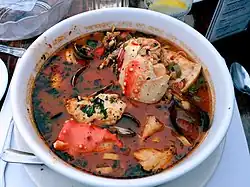
The Pacific Northwest as a region includes Alaska and the state of Washington near the Canada-US border and terminates near Sacramento, California. Here, the terrain is mostly temperate rainforest on the coast mixed with pine forest as one approaches the Canada-US border inland.
One of the core favorite foodstuffs is Pacific salmon, native to many of the larger rivers of the area and often smoked or grilled on cedar planks. In Alaska, wild game like ptarmigan and moose meat feature extensively since much of the state is wilderness.
Fresh fish like steelhead trout, Pacific cod, Pacific halibut, and pollock are fished for extensively and feature on the menu of many restaurants, as do a plethora of fresh berries and vegetables, like Cameo apples from Washington state, the headquarters of the U.S. apple industry, cherries from Oregon, blackberries, and marionberries, a feature of many pies. Hazelnuts are grown extensively in this region and are a feature of baking, such as in chocolate hazelnut pie, an Oregon favorite,[190] and Almond Roca is a local candy.
This region is also heavily dominated by some notable wineries producing a high-quality product.
Like its counterpart on the opposite coast to the East, there is a grand variety of shellfish in this region. Geoducks are a native species of giant clam that have incredibly long necks; they are eaten by the bucketful and shipped to Asia for millions of dollars as they are believed to be an aphrodisiac. Gaper clams are a favorite food, often grilled or steamed in a sauce.
Native California abalone is protected as a food source, and a traditional foodway predating settlement by whites, today featuring heavily in the cooking of fine restaurants as well as in home cooking, in mirin-flavored soups (the influence of Japanese cooking is strong in the region) noodle dishes and on the barbecue.
Native Olympia oysters are served on the half shell as well as the Kumamoto oyster, introduced by Japanese immigrants and a staple at dinner as an appetizer.
California mussels are a delicacy of the region, and have been a feature of the cooking for generations. There is evidence that Native American tribes consumed them up and down the California coast for centuries.[191]
Crabs are a delicacy, and included in this are Alaskan king crab, red crab, yellow crab, and Dungeness crab. Californian and Oregonian sportsmen pursue the last three extensively using hoop nets, and prepare them in a multitude of ways.
Alaskan king crab, able to grow as large as 10 kg, is often served steamed for a whole table with lemon-butter sauce or put in chunks of salad with avocado, and native crabs are the base of dishes like the California roll, cioppino, a tomato-based fisherman's stew, and Crab Louie, another kind of salad native to San Francisco.
Favorite grains are mainly wheat, and the region is known for sourdough bread. Cheeses of the region include Humboldt Fog, Cougar Gold and Teleme.[192]
Southwest and Southern California
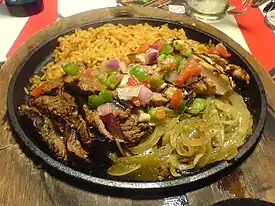
The states of the Four Corners (Arizona, New Mexico, Colorado, and Utah) plus Nevada, Southern California, and West Texas make up a large chunk of the United States.
There is a distinct Hispanic accent to the cookery here, with each having cultural capitals in Albuquerque, Denver, Las Vegas, Los Angeles, Phoenix, Santa Fe, San Diego, and Tucson.
For centuries, prior to California's statehood in the 1850s, it was part of the Spanish Empire, namely Alta California (modern California), Santa Fe de Nuevo México (modern New Mexico), and Tejas (modern Texas). Today it is home of a large population of Native Americans, Hispanos, descendants of the American frontier, Asian Americans, and immigrants from Mexico and Latin America.
California, New Mexico, and Texas continue to hold their unique identities which is reflected in their distinct regional cuisines, the multiple cuisines of California, New Mexican cuisine, Texan cuisine, and Tex-Mex. Spanish is a commonly spoken secondary language here; the state of New Mexico has its own distinct dialect.[193]
With the exception of Southern California, the signature meat is beef, since this is one of the two regions in which cowboys lived and modern cattle ranchers still eke out their living today.[194][195] High-quality beefstock is a feature that has been present in the region for more than 200 years and the many cuts of beef are unique to the United States. These cuts of meat are different from the related Mexican cuisine over the border in that certain kind of offal, like lengua (tongue) cabeza (head) and tripas (tripe) are considered less desirable and are thus less emphasized. Typical cuts would include the ribs, brisket, sirloin, flank steak, skirt steak, and t-bone.

Historically, Spanish settlers that came to the region found it completely unsuitable to the mining operations that much older settlements in Mexico had to offer as their technology was not advanced enough to extract the silver that would later be found. They had no knowledge of the gold in California, which would not be found until 1848, and knew even less about the silver in Nevada, undiscovered until after the Civil War.
Instead, in order to make the pueblos prosper, they adapted the old rancho system of places like Andalusia in Spain and brought the earliest beefstock, among these were breeds that would go feral and become the Texas longhorn, and Navajo-Churro sheep, still used as breeding stock because they are easy to keep and well adapted to the extremely arid and hot climate, where temperatures easily exceed 38 °C.[196]
Later, cowboys learned from their management practices, many of which still stand today, like the practical management of stock on horseback using the Western saddle.[197]

Likewise, settlers learned the cooking methods of those who came before and local tribes as well, for example, portions of Arizona and New Mexico still use the aforementioned beehive shaped clay contraption called an horno, an outdoor wood-fired oven both Native American tribes like the Navajo and Spaniards used for roasting meat, maize, and baking bread.[198]
Meats that see frequent use are elk meat, a favorite in crown roasts and burgers, and nearer the Mexican border rattlesnake, often skinned and stewed.[199][200]
The taste for alcohol tends toward light and clean flavors found in tequila, a staple of this region since the days of the Wild West and a staple in the bartender's arsenal for cocktails, especially in Las Vegas. In Utah, a state heavily populated by Mormons, alcohol is frowned upon by the Church of Jesus Christ of Latter-day Saints but still available in area bars in Salt Lake City, mainly consumed by the populations of Catholics and other Protestant denominations living there.
Introduction of agriculture was limited prior to the 20th century and the development of better irrigation techniques, but included the addition of peaches, a crop still celebrated by Native American tribes like the Havasupai,[201] and oranges. Today in Arizona, Texas, and New Mexico the favored orange today is the Moro blood orange, which often finds its way into the local cuisine, like cakes and marmalade.[202][203]
Pine nuts are a particular regional specialty and feature often in fine dining and cookies; in Nevada the Native American tribes that live there are by treaty given rights to exclusive harvest, and in New Mexico they reserve usage of the term piñon for certain species of indigenous pine nuts.[204]
From Native Americans, Westerners learned the practice of eating cactus fruit from the myriad species of opuntia that occupy the Chihuahuan, Sonoran, and Mojave desert lands. In California, Spanish missionaries brought with them the mission fig, and today this fruit is a delicacy.
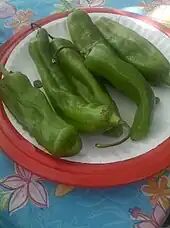
Cuisine in this region tends to have certain key ingredients: tomatoes, onions, black beans, pinto beans, rice, bell peppers, chile peppers, and cheese, in particular Monterey Jack, invented in Southern California in the 19th century and itself often further altered into pepper Jack where spicy jalapeño peppers are incorporated into the cheese to create a smoky taste.
Chili peppers play an important role in the cuisine, with a few native to the region. This is especially true with the region's distinct New Mexico chile pepper, still grown by Hispanos of New Mexico and Puebloans the most sought after of which come from the Hatch valley, Albuquerque's Central Rio Grande, Chimayo, and Pueblos.
In New Mexico, chile is eaten on a variety of foods, such as the green chile cheeseburger, made popular by fast food chains such as Blake's Lotaburger. Indeed, even national fast food chains operating in the state, such as McDonald's, offer locally grown chile on many of their menu items.
In the 20th century a few more recent additions have arrived like the poblano pepper, rocoto pepper, ghost pepper, thai chili pepper, and Korean pepper, the last three especially when discussing Southern California and its large population from East and South Asia.[205][206]
Cornbread is consumed, however the recipe differs from ones in the East in that the batter is cooked in a cast-iron skillet.
Outdoor cooking is popular and still utilizes an old method settlers brought from the East with them, in which a cast-iron Dutch oven is covered with the coals of the fire and stacked or hung from a tripod: this is different from the earthenware pots of Mexico.
Tortillas are still made the traditional way here and form an important component of the spicy breakfast burrito, which contains ham, eggs, and salsa or pico de gallo. They are also used for regular burritos, which contains any combination of marinated meats, vegetables, and piquant chilis; smothered burritos, often both containing and topped with New Mexico chile sauces; quesadillas, a much loved grilled dish where cheese and other ingredients are stuffed between two tortillas and served by the slice; and steak fajitas, where sliced skirt steak sizzles in a skillet with caramelized onions.

Unlike Mexico, tortillas of this region also may incorporate vegetables like spinach into the flatbread dough to make wraps, which were invented in Southern California. Food here tends to use pungent spices and condiments, typically chili verde sauce, various kinds of hot sauce, sriracha sauce, chili powder, cayenne pepper, white pepper, cumin, paprika, onion powder, thyme and black pepper. Nowhere is this fiery mix of spice more evident than in the dishes chili con carne, a meaty stew, and cowboy beans, both of which are a feature of regional cookoffs.
Southern California has several additions like five spice powder, rosemary, curry powder, kimchi, and lemongrass, with many of these brought by recent immigration to the region and often a feature of Southern California's fusion cuisine, popular in fine dining.
In Texas, the local barbecue is often entirely made up of beef brisket or large rib racks, where the meat is seasoned with a spice rub and cooked over coals of mesquite. In other portions of the state they smoke the meat and peppery sausages over high heat using pecan, apple, and oak wood and serve it with a side of pickled vegetables, a legacy of German and Czech settlers of the late 1800s.
California is home to Santa Maria–style barbecue, where the spices involved generally are black pepper, paprika, and garlic salt, and grill over the coals of coast live oak.[207]
Native American additions may include Navajo frybread and corn on the cob, often roasted on the grill in its husk. A typical accompaniment or appetizer of all these states is the tortilla chip, which sometimes includes cornmeal from cultivars of corn that are blue or red in addition to the standard yellow of sweetcorn, and is served with salsa of varying hotness.
Tortilla chips also are an ingredient in the Tex Mex dish nachos, where these chips are loaded with any combination of ground beef, melted Monterey Jack, cheddar, or Colby cheese, guacamole, sour cream, and salsa, and Texas usually prefers a version of potato salad as a side dish.
For alcohol, a key ingredient is tequila: this spirit has been made on both sides of the US-Mexican border for generations,[208] and in modern cuisine it is a must-have in a bartender's arsenal as well as an addition to dishes for sauteeing.[209]
Southern California is focused more towards the coast and has had more contact with immigration from the West Pacific and Baja California, in addition to having the international city of Los Angeles as its capital. Here, the prime mode of transportation is by car.
Drive through fast food was invented in this area, but so was the concept of the gourmet burger movement, giving birth to chains like In-N-Out Burger, with many variations of burgers including chili, multiple patties, avocado, special sauces, and Angus or wagyu beef. Common accompaniments include thick milkshakes in various flavors like mint, chocolate, peanut butter, vanilla, strawberry, and mango.
Smoothies are a common breakfast item made with fresh fruit juice, yogurt, and crushed ice. Agua fresca, a drink originated by Mexican immigrants, is a common hot-weather beverage sold in many supermarkets and at mom and pop stands, available in citrus, watermelon, and strawberry flavors; the California version usually served chilled without grain in it.

The weather in Southern California is such that the temperature rarely drops below 54 °F (12 °C) in winter, thus, sun-loving crops like pistachios, kiwifruit, avocadoes, strawberries, and tomatoes are staple crops of the region, the last often dried in the sun and a feature of salads and sandwiches.
Olive oil is a staple cooking oil of the region and has been since the days of Junípero Serra; today the mission olive is a common tree growing in a Southern Californian's back garden. As a crop olives are increasingly a signature of the region along with Valencia oranges and Meyer lemons.
Soybeans, bok choy, Japanese persimmon, thai basil, Napa cabbage, nori, mandarin oranges, water chestnuts, and mung beans are other crops brought to the region from East Asia and are common additions to salads as the emphasis on fresh produce in both Southern and Northern California is strong.
Other vegetables and herbs have a distinct Mediterranean flavor which would include oregano, basil, summer squash, eggplant, and broccoli, with all of the above extensively available at farmers' markets all around Southern California.
Naturally, salads native to Southern California tend to be hearty affairs, like Cobb salad and Chinese chicken salad, and dressings like green goddess and ranch are a staple.
California-style pizza tends to have disparate ingredients with an emphasis on vegetables, with any combination of chili oil, prawns, eggs, chicken, shiitake mushrooms, olives, bell pepper, goat cheese, and feta cheese. Peanut noodles tend to include a sweet dressing with lo mein noodles and chopped peanuts.
Fresh fish and shellfish in Southern California tends to be expensive in restaurants, but every year since the end of WWII, the Pismo clam festival has taken place where the local population takes a large species of clam and bakes, stuffs, and roasts it as it is a regional delicacy.[210][211]
Fishing for pacific species of octopus and the Humboldt squid are common, and both are a feature of East Asian and other L.A. fish markets.[212][213][214] Lingcod is a coveted regional fish that is often caught in the autumn off the coast of San Diego and in the Channel Islands and often served baked. California sheephead are often grilled and are much sought after by spear fishermen and the immigrant Chinese population, in which case it is basket steamed.
Most revered of all in recent years is the California spiny lobster, a beast that can grow to 44 lb, and is a delicacy that now rivals the fishery for Dungeness crab in its importance.[215]
Pacific and Hawaiian cuisine
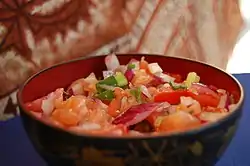
Hawaii is often considered to be one of the most culturally diverse U.S. states, as well as being the only state with an Asian-majority population and one of the few places where United States territory extends into the tropics. As a result, Hawaiian cuisine borrows elements of a variety of cuisines, particularly those of Asian and Pacific-rim cultures, as well as traditional native Hawaiian and a few additions from the American mainland.
American influence in the last 150 years has brought cattle, goats, and sheep to the islands, introducing cheese, butter, and yogurt products, as well as crops like red cabbage.
Major Asian and Polynesian influences on modern Hawaiian cuisine are from Japan, Korea, Vietnam, China (especially near the Pearl River delta,) Samoa, and the Philippines. From Japan, the concept of serving raw fish as a meal with rice was introduced, as was soft tofu, setting the stage for the popular dish called poke.
From Korea, immigrants to Hawaii brought a love of spicy garlic marinades for meat and kimchi. From China, their version of char siu baau became modern manapua, a type of steamed pork bun with a spicy filling.[216]
Filipinos brought vinegar, bagoong, and lumpia, and during the 20th century immigrants from American Samoa brought the open pit fire umu[217] and the Vietnamese introduced lemongrass and fish sauce.
Each East Asian culture brought several different kinds of noodles, including udon, ramen, mei fun, and pho, and today these are common lunchtime meals.[218]
Much of this cuisine mixes and melts into traditions like the lu'au, whose traditional elaborate fare was once the prerogative of kings and queens but is today the subject of parties for both tourists and also private parties for the ‘ohana (meaning family and close friends.)
Traditionally, women and men ate separately under the Hawaiian kapu system, a system of religious beliefs that honored the Hawaiian gods similar to the Maori tapu system, though in this case had some specific prohibitions towards females eating things like coconut, pork, turtle meat, and bananas as these were considered parts of the male gods. Punishment for violation could be severe, as a woman might endanger a man's mana, or soul, by eating with him or otherwise by eating the forbidden food because doing so dishonored the male gods.
As the system broke down after 1810, introductions of foods from laborers on plantations began to be included at feasts and much cross pollination occurred, where Asian foodstuffs mixed with Polynesian foodstuffs like breadfruit, kukui nuts, and purple sweet potatoes.
Some notable Hawaiian fare includes seared ahi tuna, opakapaka (snapper) with passionfruit, Hawaiian island-raised lamb, beef and meat products, Hawaiian plate lunch, and Molokai shrimp. Seafood traditionally is caught fresh in Hawaiian waters, and particular delicacies are ula poni, papaikualoa, ‘opihi, and ‘opihi malihini, better known as Hawaiian spiny lobster, Kona crab, Hawaiian limpet, and abalone, the last brought over with Japanese immigrants.[219]
Some cuisine also incorporates a broad variety of produce and locally grown agricultural products, including tomatoes, sweet Maui onions, taro, and macadamia nuts. Tropical fruits also play an important role in the cuisine as a flavoring in cocktails and in desserts, including local cultivars of bananas, sweetsop, mangoes, lychee, coconuts, papayas, and lilikoi (passionfruit). Pineapples have been an island staple since the 19th century and figure into many marinades and drinks.
Common dishes found on a regional level

 New York–style pizza served at a pizzeria in New York
New York–style pizza served at a pizzeria in New York Chicago-style deep-dish pizza from the original Giordano's location
Chicago-style deep-dish pizza from the original Giordano's location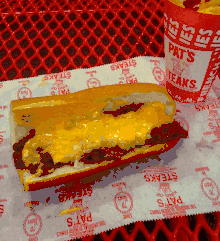 A Philly cheesesteak from Pat's King of Steaks in Philadelphia
A Philly cheesesteak from Pat's King of Steaks in Philadelphia Key lime pie is from Key West, Florida.
Key lime pie is from Key West, Florida.

 New York–style cheesecake
New York–style cheesecake Chicago-style hot dog
Chicago-style hot dog Boston cream pie
Boston cream pie
Ethnicity-specific and immigrant influence

The influence of ethnicity-specific cuisines like Italian cuisine and Mexican cuisine was present in the United States by World War I. There are recipes for Chilean meat pies, chicken chop suey, chow mein, Mexican pork pastries and Italian meatballs going back to at least the 1930s, but many of the recipes were Anglicized and they appeared relatively infrequently compared to Northern European recipes.[220]
19th-century cookbooks bear evidence of diverse influences with some including recipes like Indian pickle, Italian pork and various curries. 19th-century literature shows knowledge of Jewish, Russian, Italian, Chinese and Greek-American cuisines, and foreign cookbooks continued to grow more detailed through World War I including recipes like Peruvian chicken, Mexican enchiladas, Chilean corn pudding and Hindustan chicken curry.[221]
Louise Rice, author of Dainty Dishes from Foreign Lands describes the recipes in her book as "not wholly vegetarian" though noting at the time of publication in 1911 that most of the recipes would likely be new to average American cooks and likely contain higher proportions of vegetables to meat. She includes Italian pasta recipes like macaroni in milk, soups and polentas and German recipes like liver dumplings called Leberknödel and a variation of Sauerbraten.[222]
The demand for ethnic foods in the United States reflects the nation's changing diversity as well as its development over time. According to the National Restaurant Association,[223]
Restaurant industry sales are expected to reach a record high of $476 billion in 2005, an increase of 4.9 percent over 2004... Driven by consumer demand, the ethnic food market reached record sales in 2002, and has emerged as the fastest growing category in the food and beverage product sector, according to USBX Advisory Services. Minorities in the U.S. spend a combined $142 billion on food and by 2010, America's ethnic population is expected to grow by 40 percent.
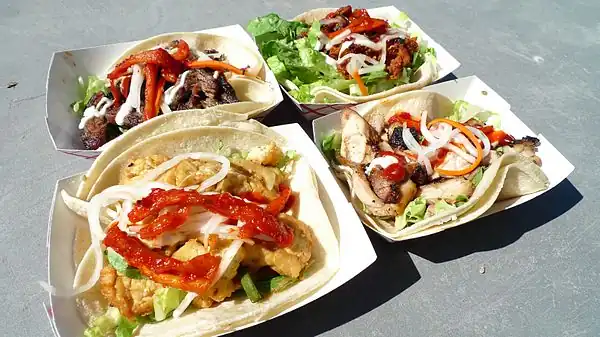
A movement began during the 1980s among popular leading chefs to reclaim America's ethnic foods within its regional traditions, where these trends originated. One of the earliest was Paul Prudhomme, who in 1984 began the introduction of his influential cookbook, Paul Prodhomme's Louisiana Kitchen, by describing the over 200-year history of Creole and Cajun cooking; he aims to "preserve and expand the Louisiana tradition."[224] Prodhomme's success quickly inspired other chefs. Norman Van Aken embraced a Floridian type cuisine fused with many ethnic and globalized elements in his Feast of Sunlight cookbook in 1988. California became swept up in the movement, then seemingly started to lead the trend itself, in, for example, the popular restaurant Chez Panisse in Berkeley.
Examples of the Chez Panisse phenomenon, chefs who embraced a new globalized cuisine, were celebrity chefs like Jeremiah Tower and Wolfgang Puck, both former colleagues at the restaurant. Puck went on to describe his belief in contemporary, new style American cuisine in the introduction to The Wolfgang Puck Cookbook:
Another major breakthrough, whose originators were once thought to be crazy, is the mixing of ethnic cuisines. It is not at all uncommon to find raw fish listed next to tortillas on the same menu. Ethnic crossovers also occur when distinct elements meet in a single recipe. This country is, after all, a huge melting pot. Why should its cooking not illustrate the American transformation of diversity into unity?[225]
Puck's former colleague, Jeremiah Tower became synonymous with California Cuisine and the overall American culinary revolution. Meanwhile, the restaurant that inspired both Puck and Tower became a distinguished establishment, popularizing its so called "mantra" in its book by Paul Bertolli and owner Alice Waters, Chez Panisse Cooking, in 1988. Published well after the restaurants' founding in 1971, this new cookbook from the restaurant seemed to perfect the idea and philosophy that had developed over the years. The book embraced America's natural bounty, specifically that of California, while containing recipes that reflected Bertoli and Waters' appreciation of both northern Italian and French style foods.
Early ethnic influences

While the earliest cuisine of the United States was influenced by Native Americans, the thirteen colonies, or the antebellum South, the overall culture of the nation, its gastronomy and the growing culinary arts became ever more influenced by its changing ethnic mix and immigrant patterns from the 18th and 19th centuries unto the present. Some of the ethnic groups that continued to influence the cuisine were here in prior years; others arrived more numerously during "The Great Transatlantic Migration" (of 1870–1914) or other mass migrations.
Some of the ethnic influences could be found across the nation after the American Civil War and into the continental expansion for most of the 19th century. Ethnic influences already in the nation at that time would include the following groups and their respective cuisines:
- Select nationalities of Europe and the respective developments from early modern European cuisine of the colonial age:
- British-Americans and on-going developments in New England cuisine, the national traditions founded in the cuisine of the original thirteen colonies, The Cuisine of the Southern United States, and many aspects of other regional cuisine.
- Spanish Americans and early modern Spanish cuisine, as well as Basque-Americans and Basque cuisine.
- Early German-American or Pennsylvania Dutch and Pennsylvania Dutch cuisine
- French Americans and their New World regional identities such as:
- Louisiana Creole and Louisiana Creole cuisine. Louisiana Creole (also called French Créole) refers to native-born people of the New Orleans area who are descended from the Colonial French and Spanish settlers of Colonial French Louisiana, before it became part of the United States in 1803 with the Louisiana Purchase.
- The various ethnicities originating from the early gastronomy and cuisines of the New World, Latin American cuisine, and North American cuisine:
- Native Americans in the United States and Native American cuisine
- African Americans and Soul food.
- Puerto Rican cuisine
- Mexican Americans and Mexican-American cuisine; as well as related regional cuisines:
- Tex-Mex (regional Texas and Mexican fusion)
- Some aspects of "Southwestern cuisine".
- New Mexican cuisine from New Mexico and the historical region of Santa Fe de Nuevo México, and now ethnically tied to the Pueblos and Hispanos of New Mexico.
Later ethnic and immigrant influence

.jpg.webp)
Mass migrations of immigrants to the United States came over time. Historians identify several waves of migration to the United States: one from 1815 to 1860, in which some five million English, Irish, German, Scandinavian, and others from northwestern Europe came to the United States; one from 1865 to 1890, in which some 10 million immigrants, also mainly from northwestern Europe, settled; and a third from 1890 to 1914, in which 15 million immigrants, mainly from central, eastern, and southern Europe (many Austrian, Hungarian, Turkish, Lithuanian, Russian, Jewish, Greek, Italian, and Romanian) settled in the United States.[226]
Together with earlier arrivals to the United States (including the indigenous Native Americans, Hispanic and Latino Americans, particularly in the West, Southwest, and Texas; African Americans who came to the United States in the Atlantic slave trade; and early colonial migrants from Europe), these new waves of immigrants had a profound impact on national or regional cuisine. Some of these more prominent groups include the following:
- Albanian Americans—Albanian cuisine
- Arab Americans, particularly Lebanese Americans (the largest ethnic Arab group in the United States)—Arab cuisine, Lebanese cuisine
- Argentine Americans—Argentine cuisine
- Armenian Americans—Armenian cuisine
- Brazilian Americans—Brazilian cuisine
- Cambodian Americans—Cambodian cuisine
- Chinese Americans—American Chinese cuisine, Chinese cuisine
- Colombian Americans—Colombian cuisine
- Cuban Americans—Cuban cuisine
- Dominican Americans—Dominican Republic cuisine
- Dutch Americans—Dutch cuisine
- Ethiopian Americans—Eritrean Americans: Ethiopian cuisine, Eritrean cuisine in Los Angeles, Washington, D.C., Denver, New York.
- Filipino Americans—Filipino cuisine, Filipino-American cuisine
- French Americans—French cuisine
- German Americans—German cuisine (the Pennsylvania Dutch, although descended from Germans, arrived earlier than the bulk of German migrants and have distinct culinary traditions)
- Greek Americans—Greek-American cuisine, Greek cuisine, Mediterranean cuisine
- Guatemalan Americans—Guatemalan cuisine
- Haitian Americans—Haitian cuisine
- Honduran Americans—Honduran cuisine
- Hungarian Americans—Hungarian cuisine
- Indian Americans—Indian cuisine
- Irish Americans—Irish cuisine
- Italian Americans—Italian-American cuisine, Italian cuisine
- Japanese Americans—Japanese cuisine, with influences on the Hawaiian cuisine
- Jewish Americans—Jewish cuisine, with particular influence on New York City cuisine
- Korean Americans—Korean cuisine
- Lithuanian Americans—Lithuanian cuisine, Midwest
- Nicaraguan American—Nicaraguan cuisine
- Nigerian Americans—Nigerian cuisine
- Pakistani Americans—Pakistani cuisine
- Peruvian Americans—Peruvian cuisine
- Polish Americans—Polish cuisine, with particular impact on Midwest
- Polynesian Americans—Hawaiian cuisine
- Portuguese Americans—Portuguese cuisine
- Romanian Americans—Romanian cuisine
- Russian Americans—Russian cuisine, with particular impact on Midwest
- Salvadoran Americans—Salvadoran cuisine
- Scottish Americans—Scottish cuisine
- Spanish Americans—Spanish cuisine
- Thai Americans—Thai cuisine
- Turkish Americans—Turkish cuisine, Balkan cuisine
- Venezuelan Americans—Venezuelan cuisine
- Vietnamese Americans—Vietnamese cuisine
- West Indian Americans—Caribbean cuisine, Jamaican cuisine, Trinidad and Tobago cuisine, Barbadian cuisine, Bahamian cuisine
Italian, Mexican and Chinese (Cantonese) cuisines have indeed joined the mainstream. These three cuisines have become so ingrained in the American culture that they are no longer foreign to the American palate. According to the study, more than nine out of 10 consumers are familiar with and have tried these foods, and about half report eating them frequently. The research also indicates that Italian, Mexican and Chinese (Cantonese) have become so adapted to such an extent that "authenticity" is no longer a concern to customers.[227]
Contributions from these ethnic foods have become as common as traditional "American" fares such as hot dogs, hamburgers, beef steak, which are derived from German cuisine, (chicken-fried steak, for example, is a variation on German schnitzel), cherry pie, Coca-Cola, milkshakes, fried chicken (Fried chicken is of English, Scottish, and African influence), Pepsi, Dr Pepper and so on. Nowadays, Americans also have a ubiquitous consumption of foods like pizza and pasta, tacos and burritos to "General Tso's chicken" and fortune cookies. Fascination with these and other ethnic foods may also vary with region.
Other popular foods
Fast food
The United States has a large fast food industry. Major American fast food chains include McDonald's, Burger King, Wendy's, Domino's, Pizza Hut, KFC, Popeyes, Subway, Taco Bell, Arby's, Starbucks, Dunkin' Donuts, White Castle, In-N-Out Burger, Sonic Drive-In, Chick-fil-A, Church's Chicken, and Raising Cane's, among numerous other multinational, national, regional, and local chains. Traditional American fast food items are hamburgers, french fries, breaded chicken, and pizza, though several chains also offer items from different cuisines modified for American palates, such as tacos, pasta, and stir-fry. Many American fast food chains have expanded abroad to other countries, typically offering standard American fare alongside items adapted to appeal to regional tastes within their markets.[228]
Desserts
A classic American dessert is apple pie. Some other famous American desserts are banana split, Boston cream pie, key lime pie, and bananas foster.[229] Other famous American desserts are chocolate chip cookies, pecan pie, carrot cake, banana pudding, S'more, black and white cookies, pumpkin pie, coconut cake, funnel cake, brownies and red velvet cake.[230]
Influential figures and American cuisine on television
American chefs have been influential both in the food industry and in popular culture. Some important 19th-century American chefs include Charles Ranhofer of Delmonico's Restaurant in New York, and Bob Payton, who is credited with bringing American-style pizza to the UK.[231] Later, chefs Charles Scotto, Louis Pacquet, John Massironi were founded the American Culinary Federation in 1930, taking after similar organizations across Europe. In the 1940s, Chef James Beard hosted the first nationally televised cooking show I Love to Eat. His name is also carried by the foundation and prestigious cooking award recognizing excellence in the American cooking community.[232][233] Since Beard, many chefs and cooking personalities have taken to television, and the success of the Cooking Channel and Food Network have contributed to the popularity of American cuisine. In 1946, the Culinary Institute of America was founded by Katharine Angel and Frances Roth. This would become the United States' most prestigious culinary school, where many of the most talented American chefs would study prior to successful careers.[234][235] The American Culinary community has grown due to both restaurants and media, through the work of many talented chefs.
Influential figures
.jpg.webp)
Notable American restaurant chefs include Samin Nosrat (Salt, Fat, Acid, Heat), Thomas Keller (The French Laundry), Charlie Trotter (Trotter's), Grant Achatz (Alinea), Alfred Portale (Portale), Paul Prudhomme (K-Paul's), Paul Bertolli (Oliveto), Jonathan Waxman (Barbuto), Mark Peel (Campanile), Frank Stitt (Bottega), Alice Waters (Chez Panisse), Wolfgang Puck (Spago), Patrick O'Connell (The Inn), Eric Ripert (Le Bernardin), Todd English (Olives) and Anthony Bourdain (Les Halles). Many of these chefs have received much critical acclaim, as Keller, Achatz, Ripert and O'Connell have all received three Michelin stars, the highest distinction which a restaurant can be given. Keller was given this award for The French Laundry, Achatz for Alinea, Ripert for Le Bernardin and O'Connell for The Inn at Little Washington.[237]
Celebrity chefs have also helped to expand the culinary arts into popular culture, with chefs such as David Chang (Chef's Table), Alton Brown (Iron Chef America), Emeril Lagasse (Emeril Live), Cat Cora (Iron Chef America), Erik Davidson (Phat Erik's), Michael Symon (The Chew), Bobby Flay (Beat Bobby Flay), Ina Garten (Barefoot Contessa) and Guy Fieri (Diners, Drive-ins and Dives).[238] Many of these celebrity chefs, such as David Chang, Emeril Lagasse and Bobby Flay began their careers in restaurants before branching out into television. The shows have a wide variety of formats, including cooking competitions, such as Iron Chef, documentaries, such as Anthony Bourdain's Parts Unknown, shows that take a look into restaurants, as Chef's Table does, and shows that teach cooking. The success of food television specifically in the United States has helped American Cuisine grow around the world.
Regional cuisine chefs
Regional chefs are emerging as localized celebrity chefs with growing broader appeal, such as Peter Merriman (Hawaii Regional Cuisine), Roy Choi (Korean American Cuisine), Jerry Traunfeld, Alan Wong (Pacific Rim cuisine), Rick Bayless and Daniela Soto-Innes (traditional Mexican cuisine with modern interpretations), Norman Van Aken (New World Cuisine – fusion Latin, Caribbean, Asian, African and American), and Mark Miller (American Southwest cuisine).
See also
Types
Regional
Ethnic
Other
- High on the Hog: How African American Cuisine Transformed America
- Cuisine of Antebellum America
- List of American desserts
- List of American breads
- List of American foods
- List of American regional and fusion cuisines
- List of American breakfast foods
- Tlingit cuisine
- Cuisine of the Americas
- Cuisine of the Pennsylvania Dutch
- Cuisine of the Southern United States
- Culture of Guam § Cuisine
- American tea culture
 Food portal
Food portal
References
- "American food and the flavors of diversity". Stump & Associates. August 22, 2019.
- Freedman, Paul (2019). "American Cuisine and How It Got That Way". Department of History | Yale University.
- "A Journey Through the History of American Food in 100 Bites". NPR. November 15, 2014.
- "Food in America". Digital History.
- McWilliams, Mark (2003). "Distant Tables: Food and the Novel in Early America". Early American Literature. 38 (3): 365–393. doi:10.1353/eal.2003.0041. JSTOR 25055570. S2CID 161615724.
- Vivian, John (February 2001). "The Three Sisters: Corn, Beans and Squash". Mother Earth News.
- "The Three Sisters lesson plan" (PDF). www.njagsociety.org. Archived (PDF) from the original on October 9, 2022. Retrieved January 2, 2021.
- "Cherokee Hunting". visitcherokeenation.com.
- "Request Rejected | UWSP" (PDF). Archived (PDF) from the original on October 9, 2022.
- "Southeastern Indians, Precontact to the Present: Introductory Essay". www.socialstudies.org.
- "Request Rejected | UWSP" (PDF). Archived (PDF) from the original on October 9, 2022.
- Park, Sunmin; Hongu, Nobuko; Daily, James W. (September 2016). "Native American foods: History, culture, and influence on modern diets". Journal of Ethnic Foods. 3 (3): 171–177. doi:10.1016/j.jef.2016.08.001.
- "Southeastern Indian Hunting | Native American Netroots".
- Gladd, Joel (September 1, 2019). Navajo Diné Bahaneʼ. Archived from the original on May 11, 2022. Retrieved January 2, 2021 – via openamlitcwi.pressbooks.com.
- "American Indian Film Gallery: Apache Cooking". American Indian Film Gallery: Cultures of Apache tribes and Hopi tribes.
- "Fish taboo may be good for health - Navajo Times". www.navajotimes.com. Archived from the original on May 11, 2022. Retrieved January 2, 2021.
- "LENAPE DANCES" (PDF). delawaretribe.org. Archived (PDF) from the original on October 9, 2022. Retrieved January 2, 2021.
- Carney, Leo H. (November 22, 1981). "How the Lenapes Celebrated". The New York Times. Retrieved January 2, 2021.
- M. S., Resource Administration and Management; B. S., Natural Resources. "Atlantic Cod's Importance in American History". ThoughtCo.
- "Aboriginal New England Cuisine With Recipes | Native American Netroots".
- "In Times of Hardship, Saved by the Sea". 41ºN Magazine. December 22, 2020.
- "Narragansett Tribe: Facts, Clothes, Food and History ***". www.warpaths2peacepipes.com.
- Taft, Dave (March 16, 2017). "The Stubborn Staying Power of the Alewife Herring (Published 2017)". The New York Times. Archived from the original on January 1, 2022.
- "American Shad - Arca del Gusto".
- Olsen SL: Animals in American Indian Life: An Overview. In: Stars Above, Earth Below American Indians and Nature. edn. Edited by Bol MC. Dublin: Roberts Rinehart Publishers; 1998: 95-118.
- Speck FG, Hassrick RB, Carpenter ES: Rappahannock Taking Devices: Traps, Hunting and Fishing. Philadelphia: University of Pennsylvania and the Philadelphia Anthropological Society; 1946.
- "Powhatan Tribe: Facts, Clothes, Food and History ***". www.warpaths2peacepipes.com.
- "White Sturgeon". Kaniksu Land Trust. July 1, 2019. Archived from the original on September 24, 2020. Retrieved January 2, 2021.
- Gobalet, K.W., P.D. Schultz, T.A. Wake, and N. Siefkin. 2004. Archaeological perspectives on Native American fisheries of California, with emphasis on steelhead and salmon. Transactions of the American Fisheries Society 133:801–833.
- "Olachen Fishing | AMNH".
- "California Tribes fish use" (PDF). www.waterboards.ca.gov. 2014. Archived (PDF) from the original on October 9, 2022. Retrieved January 2, 2021.
- "Help native trout and win thousands of dollars in prizes". www.bpa.gov. Archived from the original on August 13, 2021. Retrieved January 2, 2021.
- "Western Oregon Klikatats (Klickitats)". www.oregonencyclopedia.org.
- "Homeward Hearts: A Story Of Pacific Salmon | Alicia Patterson Foundation". aliciapatterson.org. Archived from the original on April 8, 2022. Retrieved January 2, 2021.
- Kroeber, Alfred Louis (1925). Handbook of the Indians of California. Washington, D.C.: Government Printing Office.
- "Salmon Culture | Pacific Northwest tribes, Columbia River salmon". CRITFC.
- Pritzker, Barry (August 8, 1998). Native Americans: Southwest - California - Northwest Coast - Great Basin - Plateau. ABC-CLIO. ISBN 9780874368369 – via Google Books.
- Root & De Rochemont 1981:21, 22
- Root & De Rochemont 1981:31, 32
- Smith 2004:512.
- Stavely, Keith; Fitzgerald, Kathleen (2011). "Culinarily Colonized: Cookbooks in Colonial New England". Northern Hospitality: Cooking by the Book in New England. University of Massachusetts Press. pp. 7–33. ISBN 978-1558498617. JSTOR j.ctt5vk2dv. Retrieved August 12, 2016.
- Glasse 1750.
- Smith 2004:512, Vol. 1.
- Smith, Andrew (January 31, 2013). The Oxford Encyclopedia of Food and Drink in America. Oxford University Press. p. 375. ISBN 978-0-19-973496-2.
- "The Oxford Encyclopedia of Food and Drink in America". 2. January 1, 2012: 26. doi:10.1093/acref/9780199734962.001.0001.
{{cite journal}}: Cite journal requires|journal=(help) - Oliver 2005:16–19.
- Pillsbury 1998:25.
- Oliver 2005:22.
- Smith 2004:546–547, Vol. 1.
- Smith 2004:26, Vol. 2.
- Root & De Rochemont 1981:176–182
- Apple, R.W. Jr. (March 29, 2006). "Much Ado About Mutton, but Not in These Parts". The New York Times. Retrieved January 23, 2008.
Until it fell from favor after World War II, it was a favorite of most Britons, who prized mutton above lamb (from younger animals) for its texture and flavor. It has a bolder taste, a deeper color and a chewier consistency.
- Smith 2004:458–459, Vol. 2.
- Pillsbury 1998:17.
- Crowgey 1971:18–19.
- Pillsbury 1998:18.
- Pillsbury 1998:47–48.
- Pillsbury 1998:48–49.
- Smith 2004:149, Vol. 2.
- Ziegelman, Jane; Coe, Andrew (August 16, 2016). A Square Meal: A Culinary History of the Great Depression. HarperCollins. ISBN 978-0-06-221643-4.
- "Harvey Washington Wiley". Science History Institute. June 1, 2016. Retrieved June 16, 2021.
- Helen Zoe Veit, Modern Food, Moral Food: Self-Control, Science, and the Rise of Modern American Eating in the Early Twentieth Century (2013)
- Kurlansky, Mark (May 8, 2018). Milk! : a 10,000-year food fracas (First ed.). Bloomsbury Publishing. ISBN 978-1632863829.
- James D. Porterfield, Dining by Rail: The History and Recipes of America's Golden Age of Railroad Cuisine (1993)
- Stephen Fried, Appetite for America: How Visionary Businessman Fred Harvey Built a Railroad Hospitality Empire That Civilized the Wild West (Bantam; 2010)
- Bishai, David; Nalubola, Ritu (October 2002). "The History of Food Fortification in the United States" (PDF). Economic Development and Cultural Change. 51 (1): 37–53. doi:10.1086/345361. S2CID 154018967. Archived from the original (PDF) on February 2, 2019. Retrieved February 23, 2019.
- Twilley, Nicola (August 10, 2015). "How Military R&D Created The Food We Eat". Popular Science. Retrieved September 12, 2018.
- Maurer, Elizabeth (May 11, 2017). "How Highly Processed Foods Liberated 1950s Housewives". National Women's History Museum. Retrieved September 12, 2018.
- "ConAgra's Chief Is Moving to Revitalize Some Venerable Brands". The New York Times. Retrieved January 16, 2015.
- "1950s TV Turns on America". AdAge. March 28, 2005. Retrieved September 12, 2018.
- Crocker 2005.
- "Face value: Fictional Betty Crocker gives big business a human touch Deseret News (Salt Lake City)". November 14, 2007. Archived from the original on November 14, 2007. Retrieved October 14, 2017.
- Pinsker, Joe (May 8, 2017). "Americans' Bizarre Relationship With the Color of Their Food". The Atlantic. Retrieved September 12, 2018.
- Cavolt, Jessie; Dean, Kelsey; White, Madison; Salita, Helen. "Impact on American Society – The Microwave". historyoftech.mcclurken.org. Retrieved September 12, 2018.
- Foley, Jonathan (March 5, 2013). "It's Time to Rethink America's Corn System". Scientific American. Retrieved February 23, 2019.
- Gupta, Sanjay. "If we are what we eat, Americans are corn and soy". www.cnn.com. Retrieved February 23, 2019.
- K.F. Maurer, Zur Keimfreimachung von Gewürzen, Ernährungswirtschaft 5(1958) nr.1, 45-47
- Castle, Jim Vickers | Photo courtesy of White. "Famous Ohio Foods: White Castle". www.ohiomagazine.com. Retrieved October 25, 2022.
- "Threaded Spaghetti Hot Dogs Were the Best Decision I've Ever Made". Food52. July 16, 2018. Retrieved January 21, 2019.
- "Sauce your hot dogs and spaghetti, Midwest-style". Flavored Nation. Archived from the original on January 21, 2019. Retrieved January 21, 2019.
- "Asian Cuisine & Foods : Asian-Nation :: Asian American History, Demographics, & Issues". Asian-nation.org. Retrieved January 16, 2015.
- "Hamburgers & Hot Dogs - All-American Food!". Bellaonline.com. Retrieved January 16, 2015.
- "Eddie & Sam's Pizza". Eddieandsamspizza.com. Archived from the original on January 16, 2015. Retrieved January 16, 2015.
- DeFore, John. "'The Search for General Tso': SIFF Review". The Hollywood Reporter.
- "Origin of Fortune Cookies". Snopes.com. June 9, 2008. Retrieved May 30, 2017.
- "Julia Child | Biography, Cookbooks, & Facts". Encyclopedia Britannica. Retrieved October 15, 2021.
- Warren, Wilson J. (2007). Tied to the Great Packing Machine: The Midwest and Meatpacking. University of Iowa Press. pp. 143–144. ISBN 978-1-58729-774-8.
- "Some individuals, especially teen boys and adult men, also need to reduce overall intake of protein foods by decreasing intakes of meats, poultry, and eggs and increasing amounts of vegetables or other underconsumed food groups." in "2015–2020 Dietary Guidelines for Americans: Shifts Needed To Align With Healthy Eating Patterns: A Closer Look at Current Intakes and Recommended Shifts: Protein Foods" (8 ed.). U.S. Department of Health and Human Services and U.S. Department of Agriculture. December 2015. Archived from the original on January 9, 2016. Retrieved January 9, 2016.
- "Foodies". Studio 10. 2011. Archived from the original on March 22, 2014. Retrieved March 17, 2014.
- "Characteristics of Contemporary Cuisine" (PDF). LTCC Online. Archived (PDF) from the original on October 9, 2022.
- "Philip Marie Restaurant". Pulsar Studio. Retrieved March 14, 2014.
- Brewczynski, Stasia (May 4, 2022). "Destination-Worthy Vegan Dining Around New England". Eater Boston. Retrieved May 24, 2022.
- Creswell, Julie (September 8, 2021). "Plant-Based Foods Expand, With Consumers Hungry for More". The New York Times. ISSN 0362-4331. Retrieved May 24, 2022.
- Vaughn 3, Daniel (August 17, 2021). "Vegetarian Barbecue Isn't a Threat to Brisket". Texas Monthly. Retrieved May 24, 2022.
- USDA (2008). "New England Agricultural Statistics - Sweet corn".
- Wells, Pete (November 22, 2021). "A Thanksgiving History Lesson in a Handful of Corn". The New York Times. ISSN 0362-4331. Retrieved May 24, 2022.
- "USDA says Maine blueberry growers had a big 2021". Bangor Daily News. Associated Press. May 10, 2022. Retrieved May 12, 2022.
- Danforth, Feierabend & Chassman 1998:13
- Danforth, Feierabend & Chassman 1998:24–26
- "USA'S Hard Cider Revolution". Crafty Nectar. Retrieved March 31, 2019.
- "Recipes: 'The Summer Shack Cookbook'". NPR.org. Archived from the original on December 11, 2014.
- "New England Weather, Avg Temperatures - Discover New England". Discovernewengland.org. Archived from the original on November 22, 2016. Retrieved August 12, 2016.
- "Ideas in Food vs. The Steak Bomb: Reinventing the Bread". Serious Eats. July 31, 2014. Retrieved August 12, 2016.
- "New England Corn Chowder". March 20, 2020.
- "Brunch in Boston: Top breakfasts and brunches in Boston". Time Out Boston. Retrieved January 16, 2015.
- "Which State Has The Best Cheddar Cheese - Vermont or Wisconsin? - Cheese and Yogurt Making". Cheeseandyogurtmaking.com. May 1, 2014. Archived from the original on June 10, 2016. Retrieved August 12, 2016.
- "Distant Cheeses, Local Farmers: Cheddar Across Continents - culture: the word on cheese". Culturecheeesemag.com. February 7, 2013. Retrieved August 12, 2016.
- "VIAC Vermont Institute for Artisan Cheese - cheesemaking at UVM, the University of Vermont". Nutrition.uvm.edu. Archived from the original on October 20, 2016. Retrieved August 12, 2016.
- Danforth, Feierabend & Chassman 1998:12–19
- "The Cultural Capital of Everywhere". The Huffington Post. May 15, 2012. Retrieved January 16, 2015.
- "Destination America. When did they come? - PBS". Pbs.org. Retrieved January 16, 2015.
- "Culinary Historians of New York: Dutch Food in Life and Art" (PDF). Culinaryhistoriansny.org. Archived from the original (PDF) on December 21, 2013. Retrieved January 16, 2015.
- "The Life of the German Settlers in Colonial Times". Germanheritage.com. Archived from the original on November 13, 2014. Retrieved January 16, 2015.
- "Irish fare in New York for St. Patrick's Day". NY Daily News. Retrieved January 16, 2015.
- "McSorley's Old Ale House". NYMag.com. Retrieved January 16, 2015.
- Olver, Lynne. "The Food Timeline: school lunch history". The Food Timeline. Retrieved January 16, 2015.
- "Everything New Is Old Again : The New Golden Age of Jewish-American Deli Food". The New York Times. Retrieved January 16, 2015.
- "Global Power City Index 2009" (PDF). The Mori Memorial Foundation. Archived (PDF) from the original on October 9, 2022. Retrieved June 1, 2012.
- "The World's 50 Best Restaurants". The World's 50 Best Restaurants. Archived from the original on June 7, 2013. Retrieved November 29, 2015.
- Beyer, Gregory (April 8, 2007). "Was He the Eggman?". The New York Times. Retrieved November 29, 2015.
- "The Waldorf - Astoria Hotel". Historic Hotels of America. Retrieved November 29, 2015.
- "History of Cheesecake, History of New York Cheesecake, Cream Cheese History, Whats Cooking America". Whatscookingamerica.net. May 26, 2015. Retrieved August 12, 2016.
- "Regions - New York Wine & Grape Foundation". Newyorkwines.org. Archived from the original on January 6, 2015. Retrieved January 16, 2015.
- "NY Apple Industry Facts - NY Apple Association". Nyapplecountry.com. Archived from the original on January 6, 2015. Retrieved January 16, 2015.
- Moon, Freda (September 24, 2014). "Sips From a Cider Spree in New York State". The New York Times. Retrieved January 16, 2015.
- "Spirits Review: Dad's Hat Rye". Drink Philly. Retrieved January 16, 2015.
- "U.S. Immigration Before 1965". HISTORY.com. Retrieved January 16, 2015.
- "Lower East Side Tenement Museum". Tenement.org. Archived from the original on February 28, 2015. Retrieved January 16, 2015.
- "The Jewish Quarter of Philadelphia". PhillyHistory Blog. Retrieved January 16, 2015.
- "Dutch Apple Pie". Myfoxny.com. Archived from the original on January 6, 2015. Retrieved January 16, 2015.
- "Where Does Coleslaw Come From and What is the Origin of the Term? - CulinaryLore.com". Culinarylore.com. May 20, 2012. Retrieved January 16, 2015.
- See entries for oliebol and oliekoek in Frederic Gomes Cassidy; Joan Houston Hall (1985). Dictionary of American Regional English: I-O. Harvard UP. p. 874. ISBN 978-0-674-20519-2.
- "Map of Oyster Regions of North America - The Oyster Guide". Oysterguide.com. Retrieved January 16, 2015.
- "Our Farmers and Producers - GrowNYC". Grownyc.org. August 14, 2007. Retrieved January 16, 2015.
- "Some Street Cart Vendors Still Delivering On Seasonal Tradition Of Roasting Chestnuts". Gothamist. Archived from the original on March 27, 2015. Retrieved January 16, 2015.
- "Day 20: Gingerbread". Why'd You Eat That?. December 20, 2011. Retrieved January 16, 2015.
- "History of the Sugar Cookie". Cook County Farm Bureau. Archived from the original on January 10, 2015. Retrieved January 16, 2015.
- "Scrapple: Pork Mush...The Pennsylvania Treat". Globalgourmet.com. Archived from the original on May 3, 1999. Retrieved January 16, 2015.
- Davis, Julie. "The History Behind the Philadelphia Soft Pretzel". About.com Travel. Archived from the original on January 10, 2015. Retrieved January 16, 2015.
- "Are Meatless Fridays Still a Thing? Does it Matter?". National Catholic Register. Retrieved January 5, 2017.
- ""Can't They Be Separated?" Italian Immigrants and Irish Workers in Gilded Age New York". THE GOTHAM CENTER FOR NEW YORK CITY HISTORY. Archived from the original on September 26, 2017. Retrieved March 31, 2019.
- "The Irish Waterfront" (PDF). Archived (PDF) from the original on October 9, 2022.
- Miller, Hugh (January 1, 1851). Scenes and Legends of the North of Scotland. W. H. Moore & D. Anderson.
- "Doughnuts on a String". Marthastewart.com. May 17, 2011. Retrieved August 2, 2017.
- Wallach, Jennifer Jensen; Swindall, Lindsey R.; Wise, Michael D. (2016). The Routledge History of American Foodways. New York: Taylor & Francis. p. 266. ISBN 9781317975236.
- Chowhound (July 1, 2019). "What Makes a Hot Dog Kosher?". Chowhound. Retrieved September 14, 2019.
- "Joey Chestnut devours record 74 hot dogs for 11th win at Nathan's Famous contest". www.cbsnews.com. Retrieved January 21, 2019.
- "Film Review: Famous Nathan | FilmJournal International". July 23, 2015. Archived from the original on September 15, 2015. Retrieved September 14, 2019.
- "How to Spend 5 Days in Puerto Rico — travelJewels". Traveljewels.net. April 9, 2018. Retrieved September 14, 2019.
- Koenig, Leah. "Beyond the Bagel: Exploring the Many Flavors of New York City's Jewish Cuisine". Serious Eats. Retrieved September 14, 2019.
- "How Did the Pickle Become a Jewish Food Staple? – the Forward". Archived from the original on June 18, 2019. Retrieved September 11, 2019.
- "Yid.Dish: Almond Horns – Forward.com". Archived from the original on March 18, 2015. Retrieved September 11, 2019.
- Koenig, Leah (March 17, 2015). Modern Jewish Cooking: Recipes & Customs for Today's Kitchen - Leah Koenig - Google Books. ISBN 9781452132327. Retrieved September 14, 2019.
- Moskin, Julia (January 10, 2017). "Rye, a Grain With Ancient Roots, Is Rising Again - The New York Times". The New York Times. Archived from the original on January 1, 2022. Retrieved September 14, 2019.
- "Russ & Daughters official site". shop.russanddaughters.com. Retrieved September 14, 2019.
- "Let's eat: Pawpaw Bread with Toasted Walnuts - Chicago Tribune". Chicago Tribune. November 7, 2017. Archived from the original on November 7, 2017. Retrieved August 8, 2019.
- "The Geography of Chicago's Second Languages". Chicagomag.com. Archived from the original on August 2, 2017. Retrieved August 2, 2017.
- "Take the pierogi: The only guide to Polish delis you'll ever need". Chicagobusinesss.com. March 10, 2016. Retrieved August 2, 2017.
- "Potluck Events: Safe Food is Good Business - EH: Minnesota Department of Health". Health.state.mn.us. Archived from the original on August 2, 2017. Retrieved August 2, 2017.
- "Sense of Place: Food and Cuisine of the Midwest". The Kitchn. Retrieved November 28, 2016.
- "What is a Hotdish? (with pictures)". wiseGEEK. Retrieved November 28, 2016.
- "Arby's to offer venison sandwiches at 4 Michigan locations". Mlive.com. October 26, 2016. Retrieved August 2, 2017.
- "Arby's venison sandwich sells out fast in Minnesota, Wisconsin". Twincities.com. November 4, 2016. Retrieved August 2, 2017.
- "Sweetooth Design Company - Food & Design - Oakland, USA". Sweetoothdesign.com. Archived from the original on August 2, 2017. Retrieved August 2, 2017.
- "Kansas train map". Trn.trains.com. Retrieved August 2, 2017.
- "Wild West Week: Kansas City and St. Louis Stockyards". Missourilife.com. September 9, 2011. Archived from the original on August 2, 2017. Retrieved August 2, 2017.
- "Archived copy". Archived from the original on May 10, 2017. Retrieved November 29, 2016.
{{cite web}}: CS1 maint: archived copy as title (link) - "Indian Head Yellow Corn Meal Recipes - Wilkins Rogers Mills". Wrmills.com. Retrieved January 16, 2015.
- "West Virginia Breaking News, Sports, Weather: WDTV.COM". Wdtv.com. Archived from the original on June 14, 2012. Retrieved January 16, 2015.
- "Southern Deer Hunting". Deer & Deer Hunting - Whitetail Deer Hunting Tips. Archived from the original on February 6, 2015. Retrieved January 16, 2015.
- "Snapping turtle makes for a delicious dinner". Arkansas Online. August 3, 2014. Retrieved January 16, 2015.
- "Taste of the South: Fried Catfish". Southern Living. Retrieved January 16, 2015.
- "State Symbols". Tn.gov. Archived from the original on June 25, 2014. Retrieved January 16, 2015.
- "Lindera benzoin (spicebush)". Monticello.org. Retrieved January 16, 2015.
- "History and development of Choctaw food - School of Choctaw Language". www.choctawschool.com. Archived from the original on August 8, 2019. Retrieved August 8, 2019.
- "Native Edibles". Southernmatters.com. Retrieved January 16, 2015.
- "Dry Curing Virginia-Style Ham - Publications and Educational Resources - Virginia Tech". Oubs.ext.vt.edu. December 18, 2012. Retrieved January 16, 2015.
- "Traits of a true Southern woman". Richmond.com. Retrieved January 16, 2015.
- "Bananas Foster". Neworleansonline.com. Retrieved January 16, 2015.
- "Louisiana Rice" (PDF). Usarice.com. Archived from the original (PDF) on December 22, 2014. Retrieved January 16, 2015.
- Covey, Herbert C.; Eisnach, Dwight (2009). What the Slaves Ate. ISBN 9780313374975. Retrieved January 16, 2015.
- Mansky, Jackie. "Food Historian Reckons With the Black Roots of Southern Food". Smithsonian. Retrieved January 21, 2019.
- "Colonial Cream of Peanut Soup".
- Rinaldi, Jay. "Pernil Al Horno (Roasted Pork Shoulder)". South Florida Gay News. Retrieved January 16, 2015.
- "Honey - from Thomas Honey Company". Thomashoney.com. Archived from the original on December 31, 2014. Retrieved January 16, 2015.
- "Bagging the Bug: How to Have A Successful Lobster-Hunting Season". Scuba Diving. Retrieved January 21, 2019.
- "What's Best, Worst, and Most Weird About American Food". National Geographic News. December 20, 2015.
- Martynuska, Małgorzata (November 27, 2017). "Cultural Hybridity in the USA exemplified by Tex-Mex cuisine" (PDF). International Review of Social Research. 7 (2): 90–98. doi:10.1515/irsr-2017-0011. ISSN 2069-8534. S2CID 54189154. Archived (PDF) from the original on October 9, 2022.
- Arellano, Gustavo (March 23, 2012). "As American as Fajita Pie". The Wall Street Journal. ISSN 0099-9660. Retrieved June 8, 2021.
- "Chocolate Bourbon Hazelnut Pie". Oregonlive.com. Retrieved January 16, 2015.
- Erlandson, Jon (2008). "Human impacts on ancient shellfish: a 10,000 year record from San Miguel Island, California". Journal of Archaeological Science. 35 (8): 2144–2152. Bibcode:2008JArSc..35.2144E. doi:10.1016/j.jas.2008.01.014. Retrieved November 16, 2022.
- Davies, S. (2010). The Guide to West Coast Cheese: More than 300 Cheeses Handcrafted in California, Oregon, and Washington. Timber Press
- "History, language and culture in New Mexico". World Travel Guide. Retrieved April 29, 2021.
- "Nevada Cattle Rancher Wins 'Range War' With Federal Government". ABC News. Retrieved January 16, 2015.
- "Welcome to the Utah Cattlemen's Association". Utahcattlemen.org. Archived from the original on December 18, 2014. Retrieved January 16, 2015.
- Hillis, David. "History of Texas Longhorns". Doublehelixranch.com. Retrieved January 16, 2015.
- "Digital History". Digitalhistory.uh.edu. Retrieved January 16, 2015.
- Green, Rayna (1999). The British Museum Encyclopedia of Native North America. London: British Museum Press. p. 4. ISBN 0-253-33597-3.
- "The Nutrition of Snake". Fitday.com. Retrieved January 16, 2015.
- "How Does Rattlesnake Taste?". Query.nytimes.com. October 2, 2011. Retrieved January 16, 2015.
- "Havasupai Tribe". Visitarizona.com. Archived from the original on February 19, 2015. Retrieved January 16, 2015.
- "Blood Orange Marmalade". Texas Monthly. June 1, 2010. Retrieved January 16, 2015.
- "Halloween Blood Orange Cake". Texas Monthly. October 31, 2013. Retrieved January 16, 2015.
- "Pine Nuts". The New Yorker. November 21, 2011. Retrieved January 16, 2015.
- "Chilis & Other Peppers". Clovegarden.com. Retrieved January 16, 2015.
- "New Mexico's green chile, the real deal". Los Angeles Times. September 23, 2009. Retrieved January 16, 2015.
- "Introduction to Santa Maria Style Barbecue". The Official Santa Maria Style Barbecue Site. February 18, 2009. Retrieved August 12, 2022.
- "In Search of the Blue Agave: Tequila History - 18th-19th Centuries". Ianchadwick.com. Retrieved January 16, 2015.
- "Closet Cooking: Tequila Lime Shrimp". Closet Cooking. June 12, 2008. Retrieved January 16, 2015.
- Young, Christopher (April 12, 2013). "Digging for Pismo clams at San Diego Beaches". San Diego Reader.
- "Dig Into the 66th Annual Pismo Beach Clam Festival". SeaCrest OceanFront Hotel. Archived from the original on June 12, 2014. Retrieved January 16, 2015.
- "Jumbo squid invasion attracts eager anglers". Los Angeles Times. January 14, 2013. Retrieved January 16, 2015.
- "Cooking the Monster Giant Squid Made Easy!". Wide Open Fishing Los Angeles Orange County Inshore Offshore Fishing. Archived from the original on December 21, 2014. Retrieved January 16, 2015.
- Koslow, Jessica A. (May 15, 2013). "10 Best Octopus Dishes in Los Angeles". LA Weekly.
- "California Lobster Battles". Boating Magazine. August 7, 2012. Retrieved January 16, 2015.
- "Getting to the Roots of Hawaii Regional Cuisine". Coffeetimes.com. Archived from the original on January 16, 2015. Retrieved January 16, 2015.
- "Polynesian Cultural Center Shares The Flavors Of Samoa With Hands-On Umu Making Activity". Polynesia.com. Retrieved January 16, 2015.
- "History of Hawaii's cuisine - The Go Lightly Gourmet". The Go Lightly Gourmet. March 8, 2011. Retrieved January 16, 2015.
- "Food La La: Kona Abalone opens at Ala Moana - Honolulu Pulse - Hawaii Entertainment, Food and NightlifeHonolulu Pulse – Hawaii Entertainment, Food and Nightlife". Honolulu Pulse - Hawaii Entertainment, Food and Nightlife. Archived from the original on January 16, 2015. Retrieved January 16, 2015.
- Sherrie A. Inness, Dinner roles: American women and culinary culture. p. 89
- Sherrie A. Inness, Dinner roles: American women and culinary culture. p. 92
- Louise Rice, Dainty Dishes From Foreign Lands, p.7-34
- Oralia 2005 (par. 6).
- Prodhomme 1984 n.p.
- Puck 1986 n.p.
- "H102 Lecture 08: Foreign Immigrants in Industrial America". March 13, 2012. Archived from the original on March 13, 2012. Retrieved August 8, 2019.
- Hensley, Sue, National Restaurant Association.Article/ News Release, "International Cuisine Reaches America's Main Street," 10 August 2000.
- How American Fast Food Franchises Expanded Abroad
- 180 Years of America's Classic Desserts: From Baked Alaska to Marionberry Pie
- The Most Iconic Desserts in America
- "Obituary: Bob Payton". The Independent. Archived from the original on April 21, 2009. Retrieved September 15, 2015.
- "Home | James Beard Foundation". www.jamesbeard.org. Retrieved October 11, 2022.
- Krebs, Albin (January 24, 1985). "James Beard, Authority On Food, Dies". The New York Times. Retrieved April 11, 2010.
James Beard, the bald and portly chef and cookbook writer who was one of the country's leading authorities on food and drink and its foremost champion of American cooking, died of cardiac arrest yesterday at the New York Hospital-Cornell Medical Center. He was 81 years old and lived in ...
- "Our Story: CIA History | Culinary Institute of America". www.ciachef.edu. Retrieved October 11, 2022.
- Averbuch, Bonnie (September 2015). "Attention Food Entrepreneurs: School's Back in Business". Food Tank. Retrieved June 19, 2017.
- Severson, Kim (May 2, 2017). "Thomas Keller, an Exacting Chef at a Crossroads". The New York Times. ISSN 0362-4331. Retrieved October 11, 2022.
- "Michelin restaurants". Michelin Guide. Retrieved October 11, 2022.
- "All Shows A-Z". Food Network. Retrieved October 11, 2022.
Works cited
- Bertolli, Paul; Waters, Alice (1988). Chez Panisse Cooking. New York: Random House..
- Betty Crocker Cookbook: Everything You Need to Know to Cook Today (10, illustrated, revised ed.). John Wiley & Sons, Incorporated. 2005. ISBN 978-0-7645-6877-0..
- Crowgey, Henry G. (1971). Kentucky Bourbon: The Early Years of Whiskeymaking. Kentucky: The University Press of Kentucky..
- Danforth, Randi; Feierabend, Peter.; Chassman, Gary. (1998). Culinaria The United States: A Culinary Discovery. New York: Konemann..
- Fried, Stephen. Appetite for America: How Visionary Businessman Fred Harvey Built a Railroad Hospitality Empire That Civilized the Wild West (Bantam; 2010)
- Glasse, Hannah (1750). Art of Cookery Made Easy. London..
- Oliver, Sandra L. (2005). Food in Colonial and Federal America. London: Greenwood Press..
- Oralia, Michael (April 5, 2005). "Demand for Ethnic & International Foods Reflects a Changing America". National Restaurant Association. Archived from the original on April 3, 2013. Retrieved March 8, 2009..
- Pillsbury, Richard (1998). No Foreign Food: The American Diet in Time and Place. Westview. ISBN 9780813327396..
- Porterfield, James D. (1993). Dining by Rail: The History and Recipes of America's Golden Age of Railroad Cuisine. New York: St. Martin's Press. ISBN 0-312-18711-4.
- Prodhomme, Paul (1984). Paul Prodhomme's Louisiana Kitchen. New York: William Morrow. ISBN 0-688-02847-0..
- Puck, Wolfgang (1986). The Wolfgang Puck Cookbook. New York: Random House. ISBN 9780394533667.
- Root, Waverly; De Rochemont, Richard (1981). Eating in America: a History. New Jersey: The Ecco Press. ISBN 9780912946887.
- Smith, Andrew F. (2004). The Oxford Encyclopedia of Food and Drink in America. Oxford: Oxford University Press..
- Tower, Jeremiah (2004). California Dish, What I Saw (and cooked) at the American Culinary Revolution. New York: Free Press/Simon & Schuster. ISBN 9780743228442..
- Tower, Jeremiah (1986). New American Classics. Harper & Row. ISBN 9780061818783..
- Van Aken, Norman (1988). Feast of Sunlight. New York: Ballantine/Random House. ISBN 0-345-34582-7.
- Veit, Helen Zoe. Modern Food, Moral Food: Self-Control, Science, and the Rise of Modern American Eating in the Early Twentieth Century (2013)
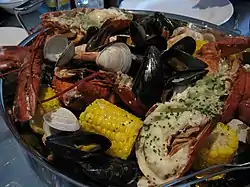




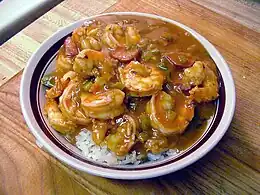


.jpg.webp)